Abstract
PURPOSE: Dissociated vertical deviation (DVD) has eluded explanation for more than a century. The purpose of this study has been to elucidate the etiology and mechanism of DVD. METHODS: Eye movement recordings of six young adults with DVD were made with dual-coil scleral search coils under various conditions of fixation, illumination, and head tilt. Horizontal, vertical, and torsional eye movements were recorded for both eyes simultaneously. Analyses of the simultaneous vertical and torsional movements occurring during the DVD response were used to separate and identify the component vergence and version eye movements involved. RESULTS: Typically, both horizontal and cyclovertical latent nystagmus developed upon occlusion of either eye. A cycloversion then occurred, with the fixing eye intorting and tending to depress, the covered eye extorting and elevating. Simultaneously, upward versions occurred for the maintenance of fixation, consisting variously of saccades and smooth eye movements, leading to further elevation of the eye behind the cover. The cyclovertical component of the latent nystagmus became partially damped as the DVD developed. CONCLUSIONS: In patients with an early-onset defect of binocular function, the occlusion of one eye, or even concentration on fixing with one eye, produces unbalanced input to the vestibular system. This results in latent nystagmus, sometimes seen only with magnification. The cyclovertical component of the latent nystagmus, when present, is similar to normal vestibular nystagmus induced by dynamic head tilting about an oblique axis. Such vestibular nystagmus characteristically produces a hyperdeviation of the eyes. In the case of cyclovertical latent nystagmus, the analogous hyperdeviation will persist unless corrected by a vertical vergence. A normal, oblique-muscle-mediated, cycloversion/vertical vergence is called into play. This occurs in the proper direction to correct the hyperdeviation, but it occurs in an exaggerated form in the absence of binocular vision, probably as a learned response. The cycloversion/vertical vergence helps damp the cyclovertical nystagmus (a cyclovertical "nystagmus block-age" phenomenon), aiding vision in the fixing eye. But this mechanism also produces unavoidable and undesirable elevation and extortion of the fellow eye, which we call DVD.
Full text
PDF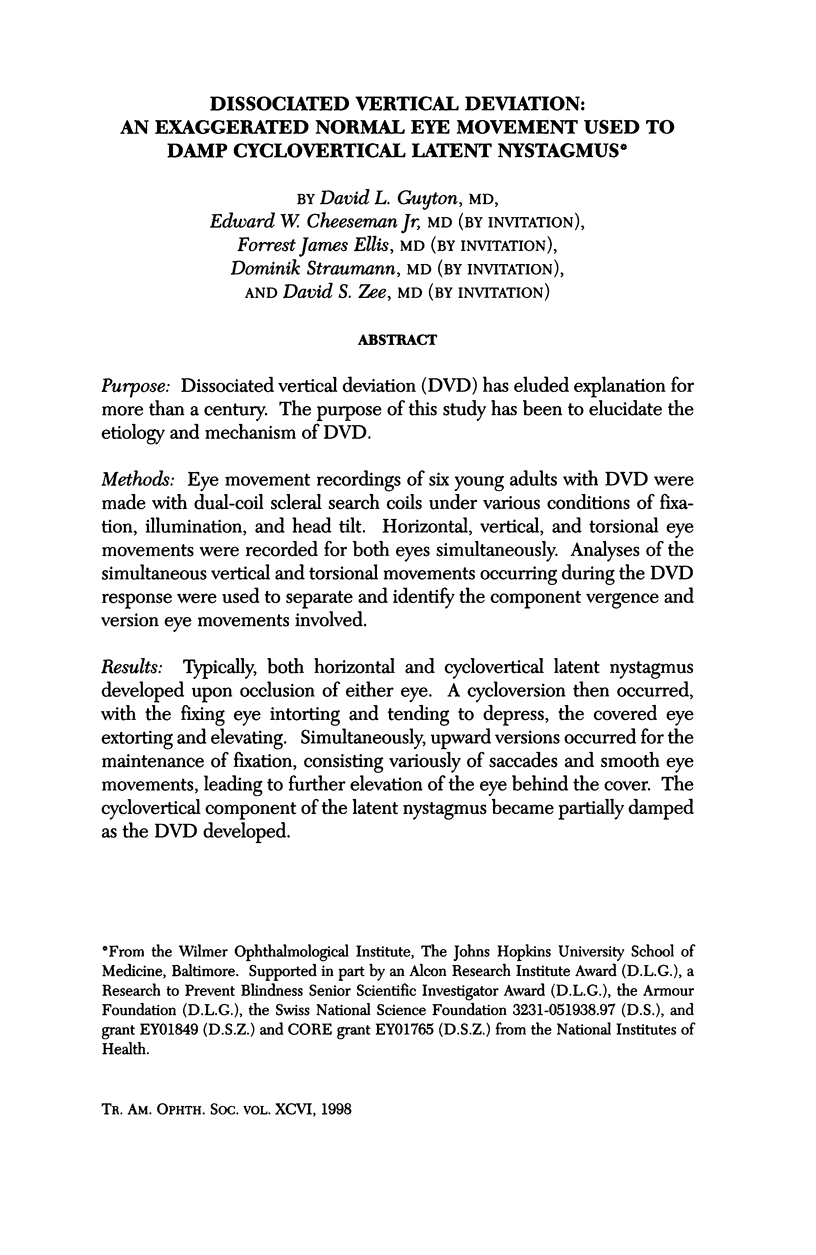
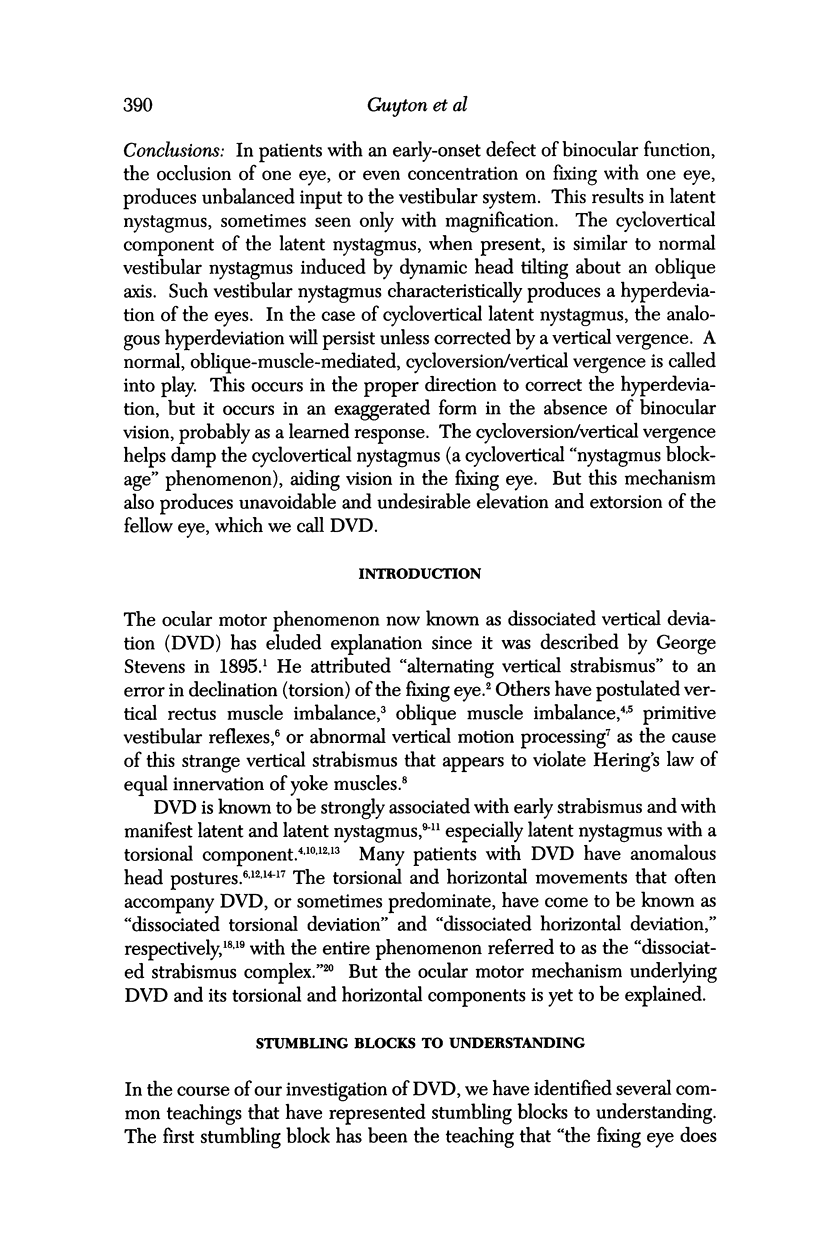
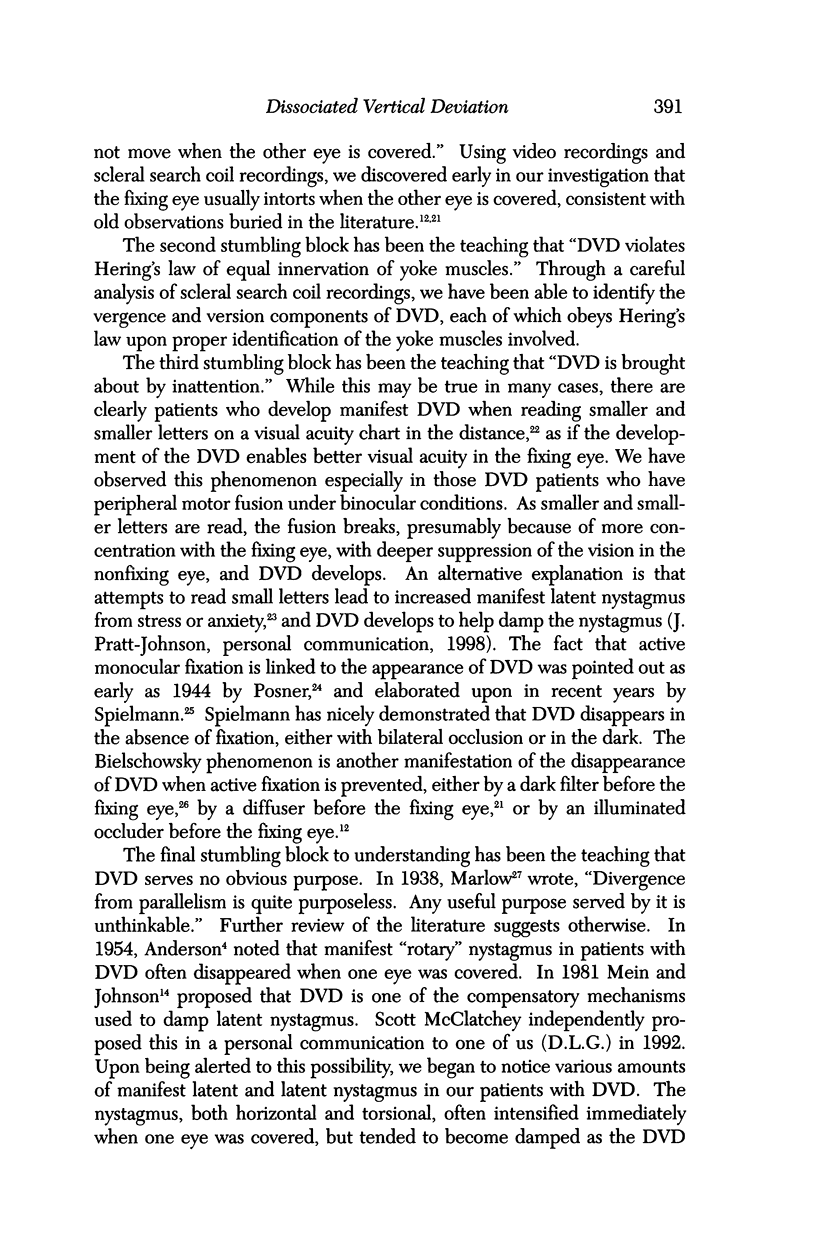
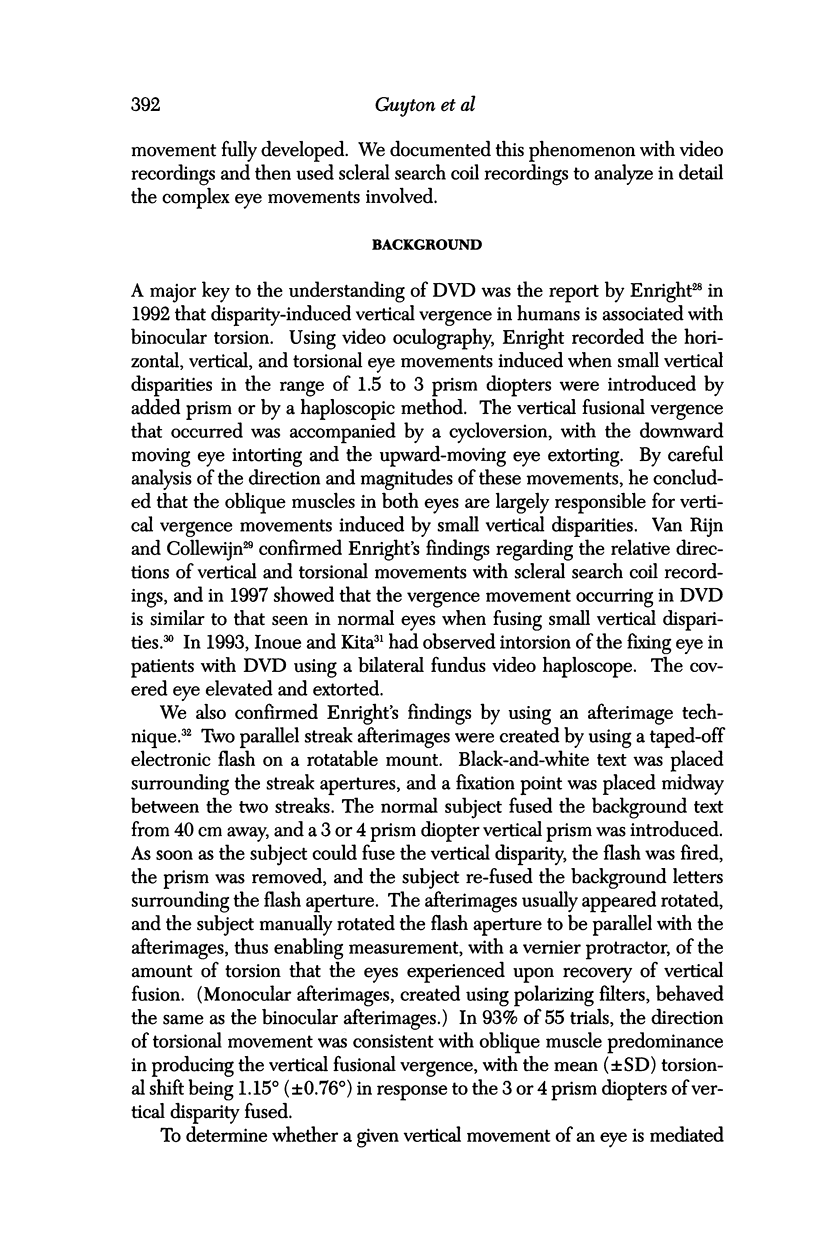
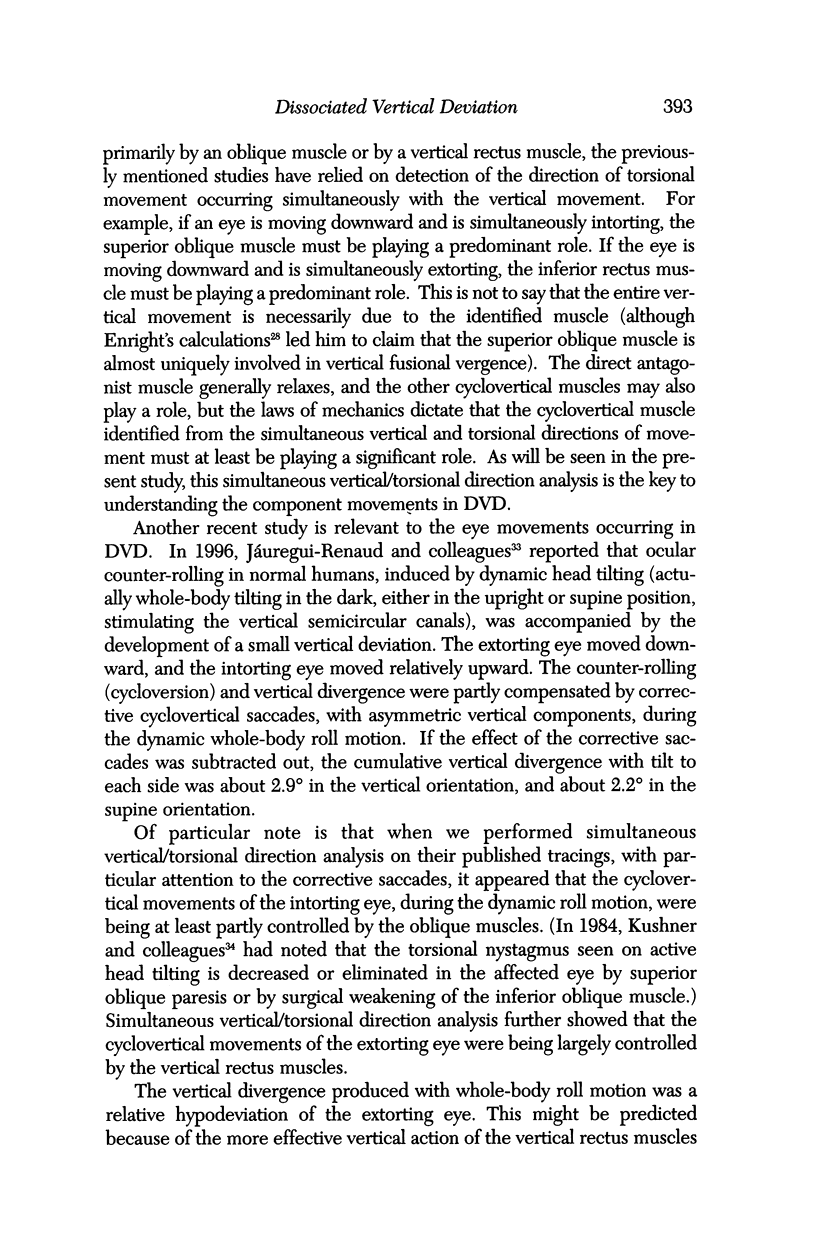
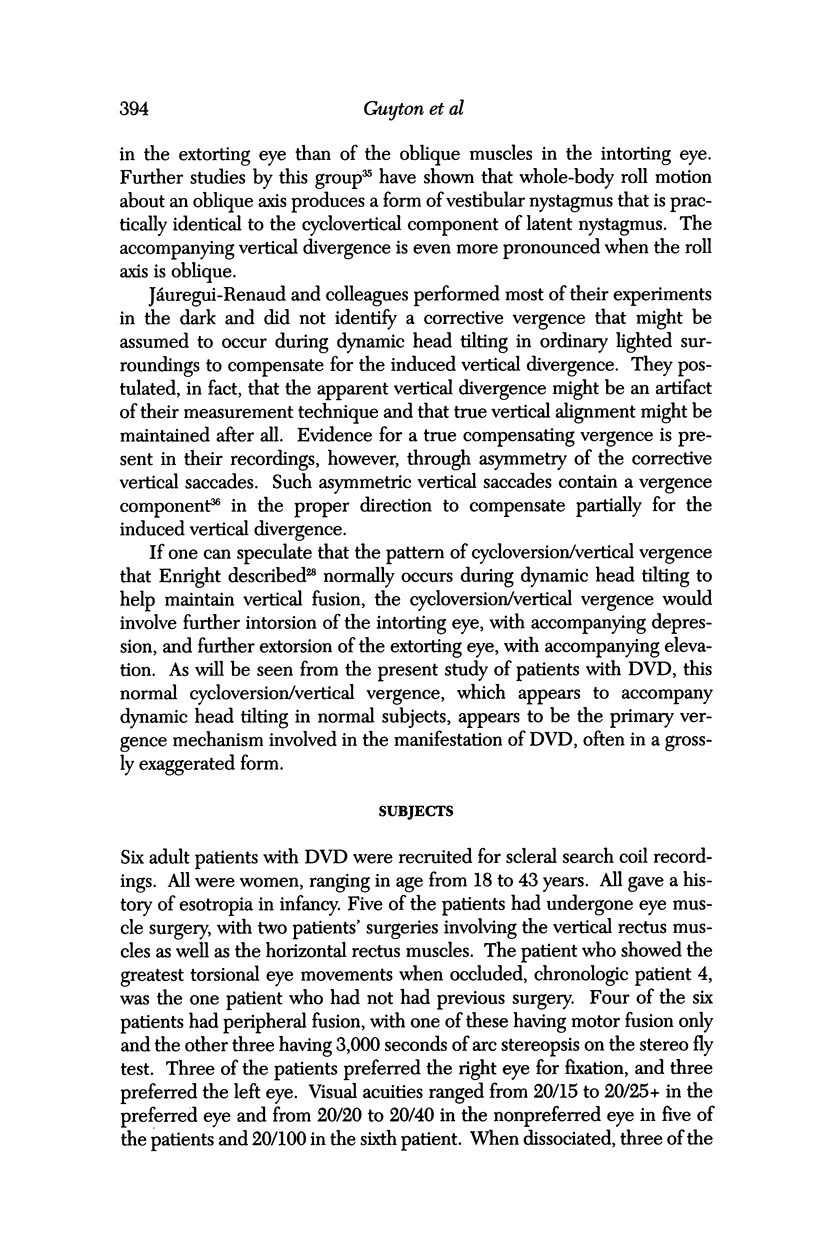
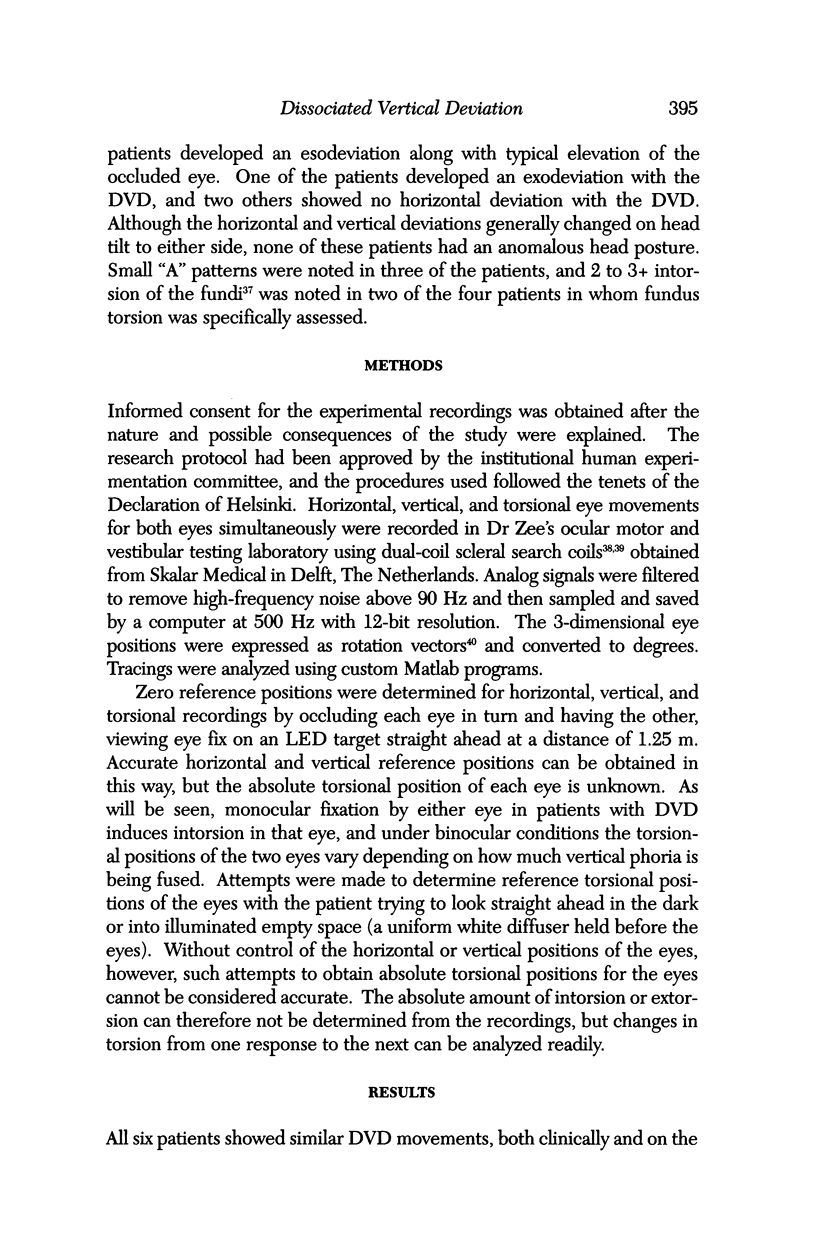
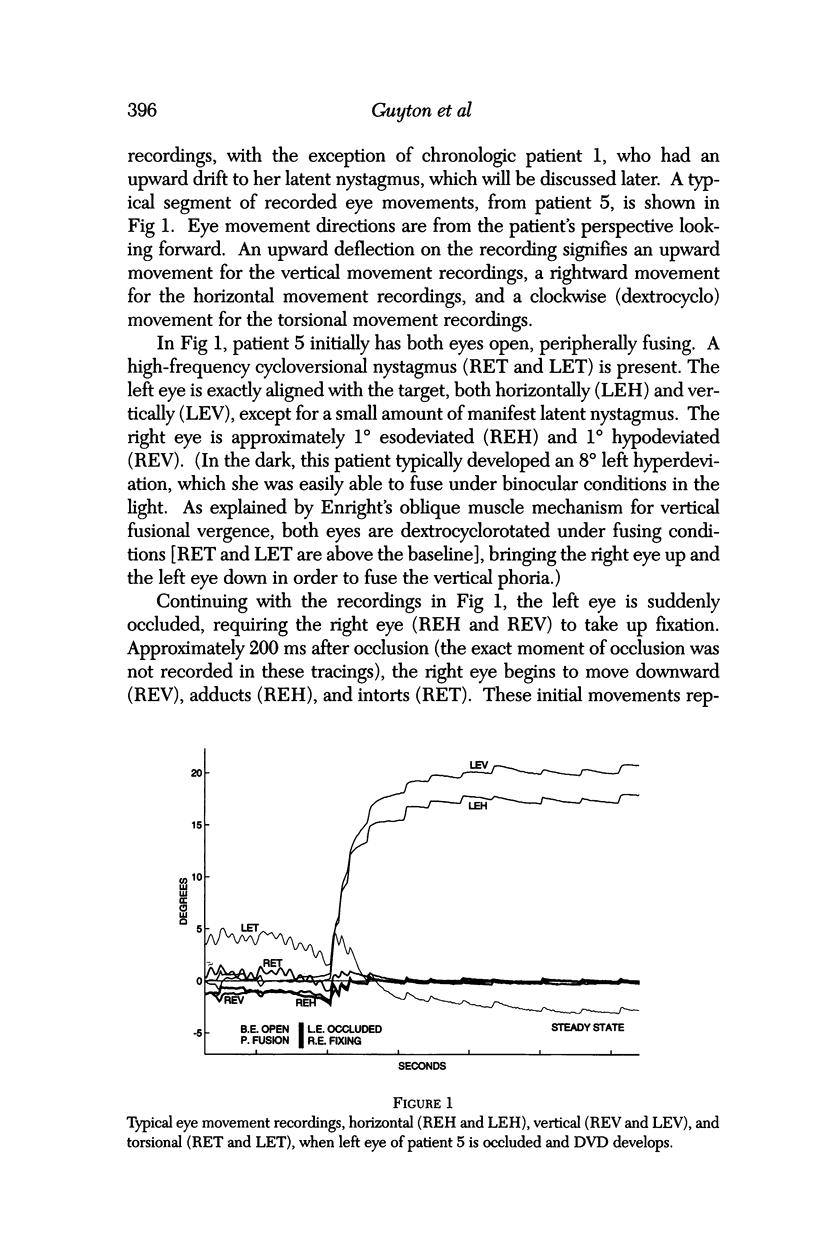
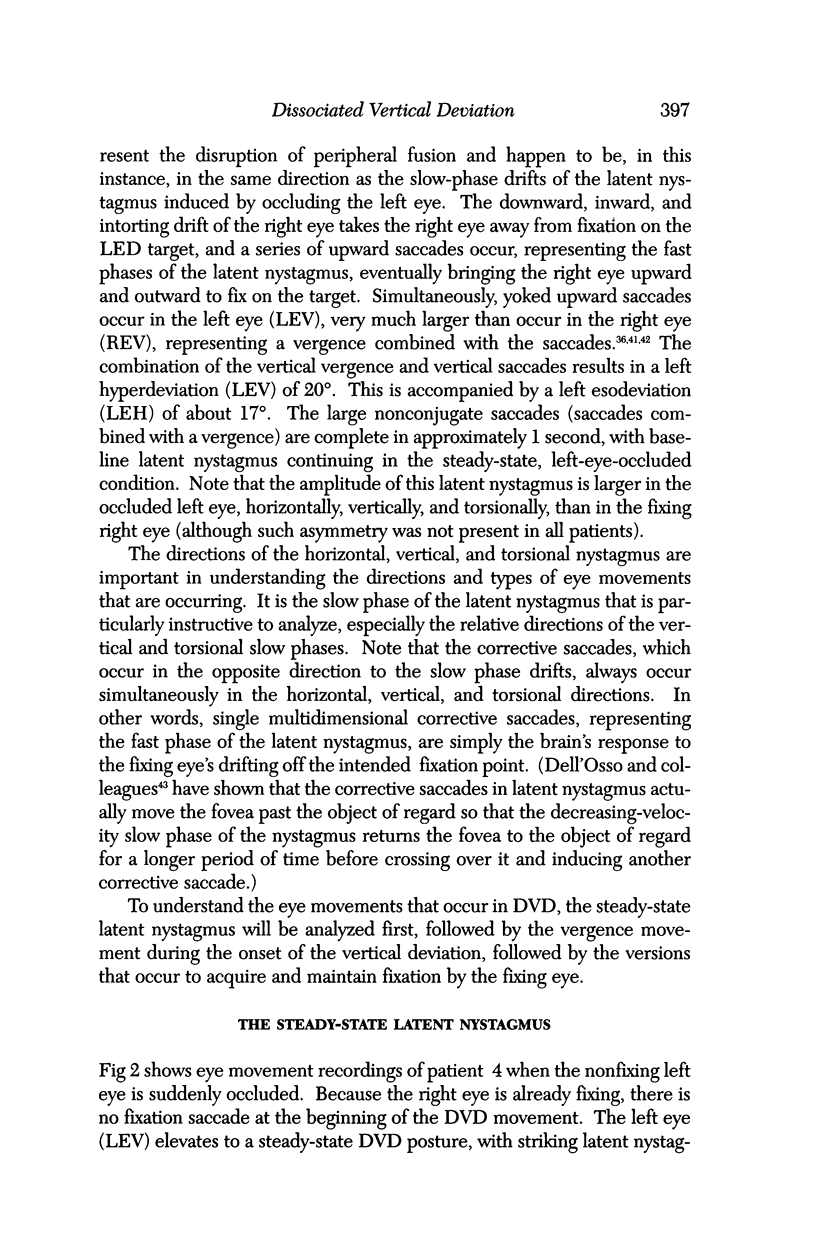
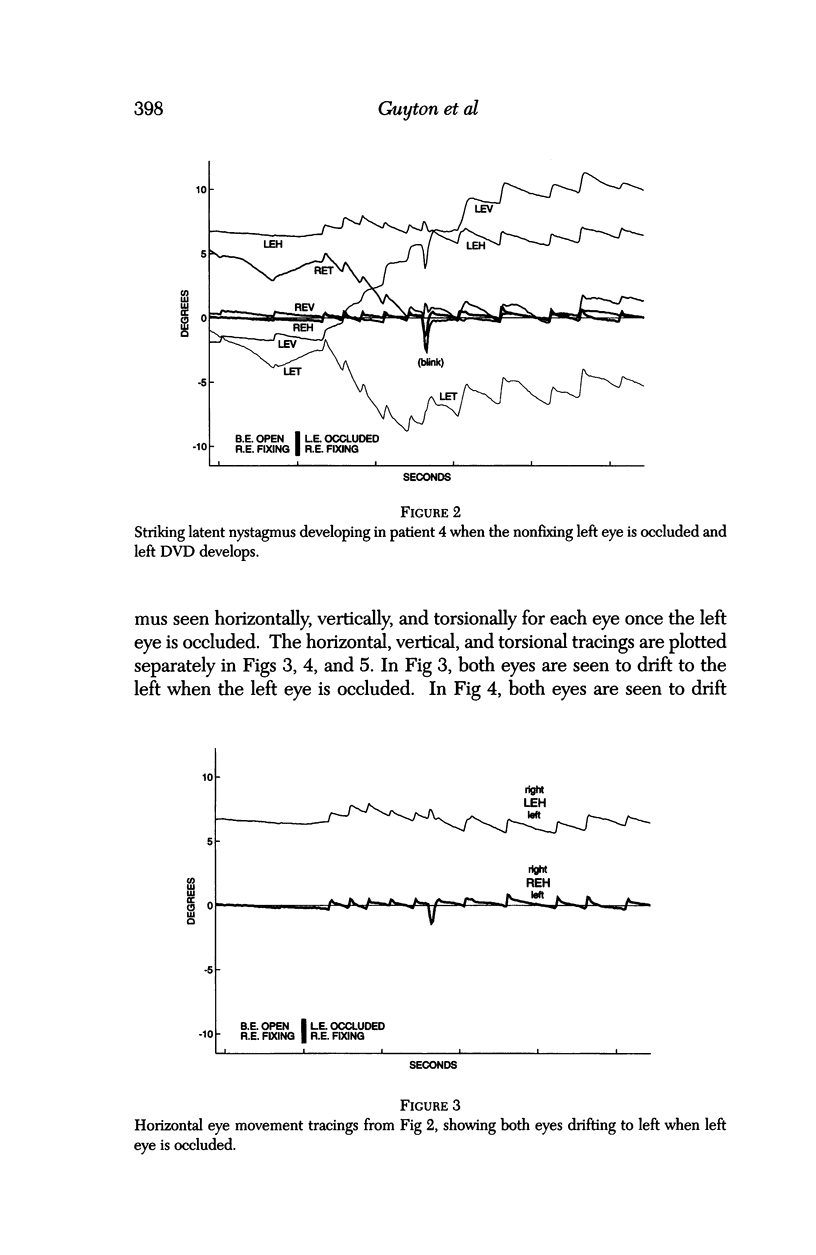
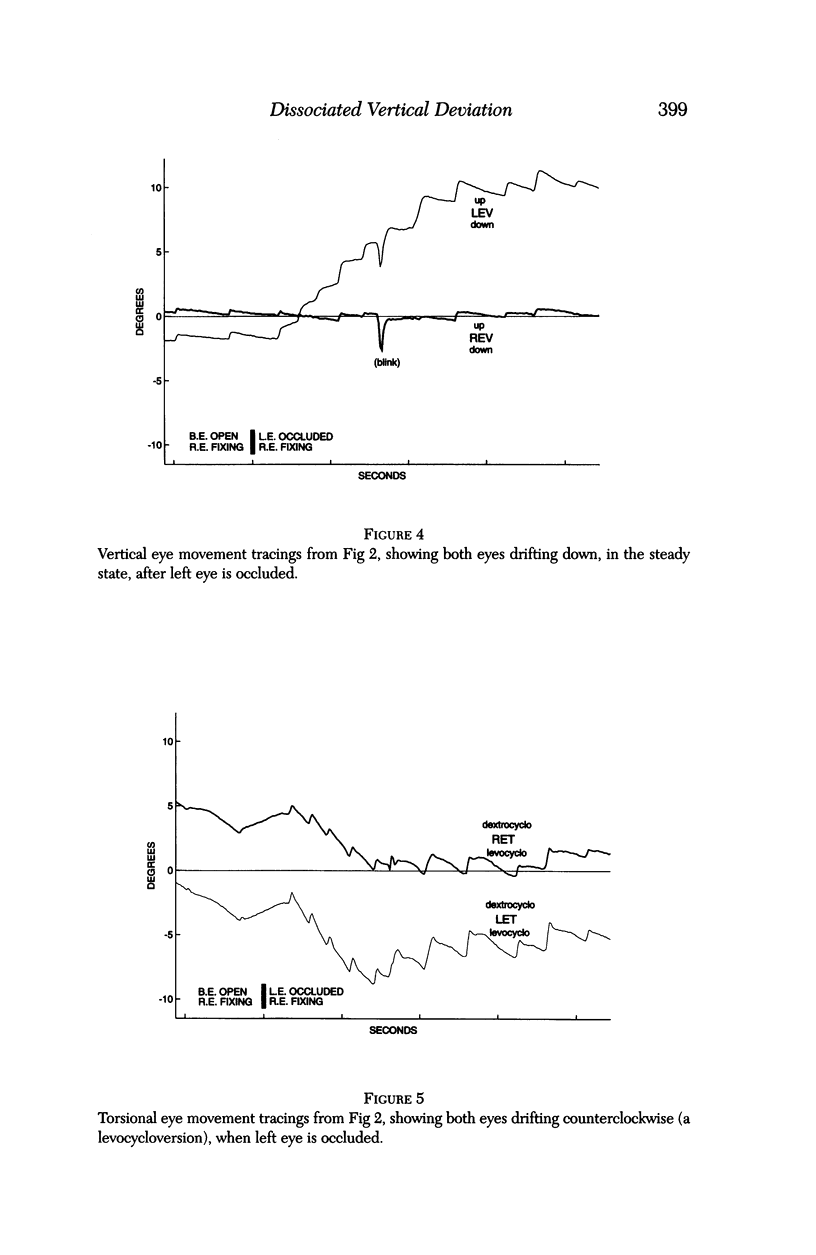
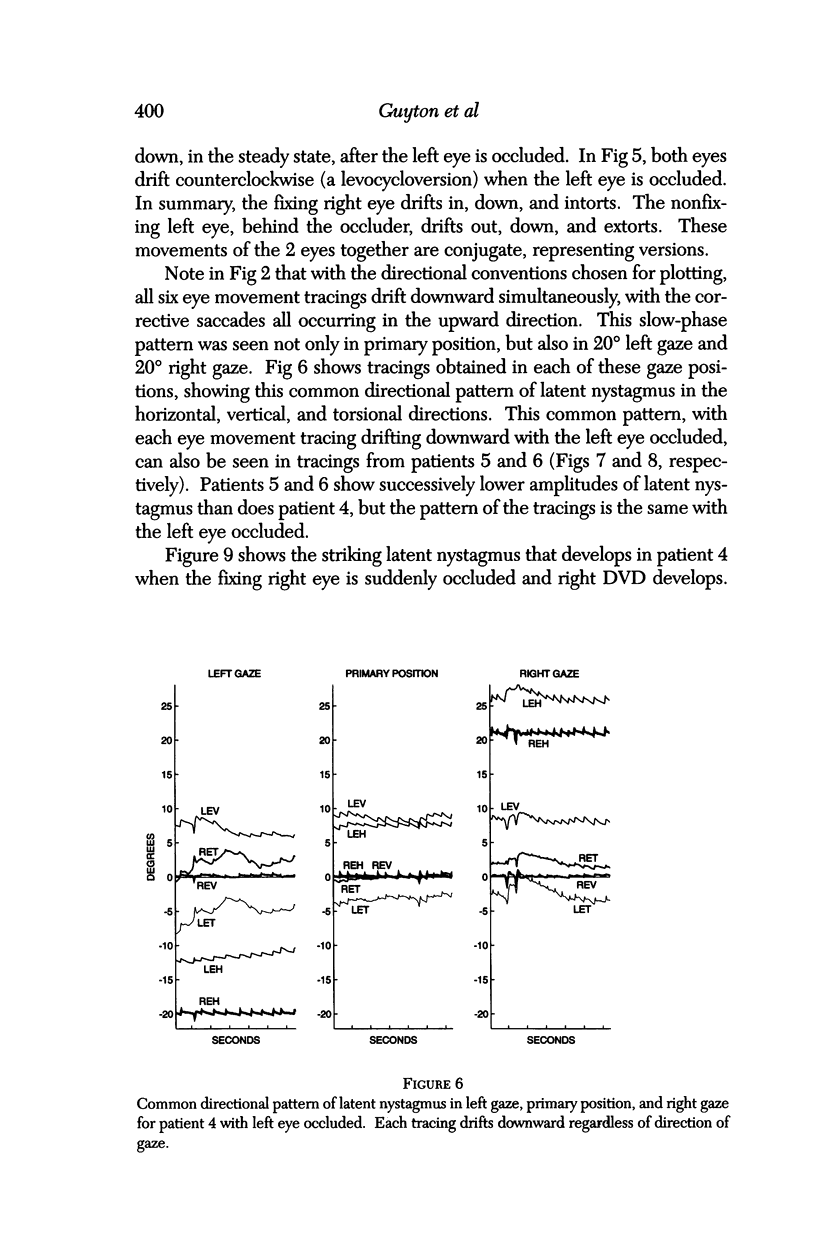
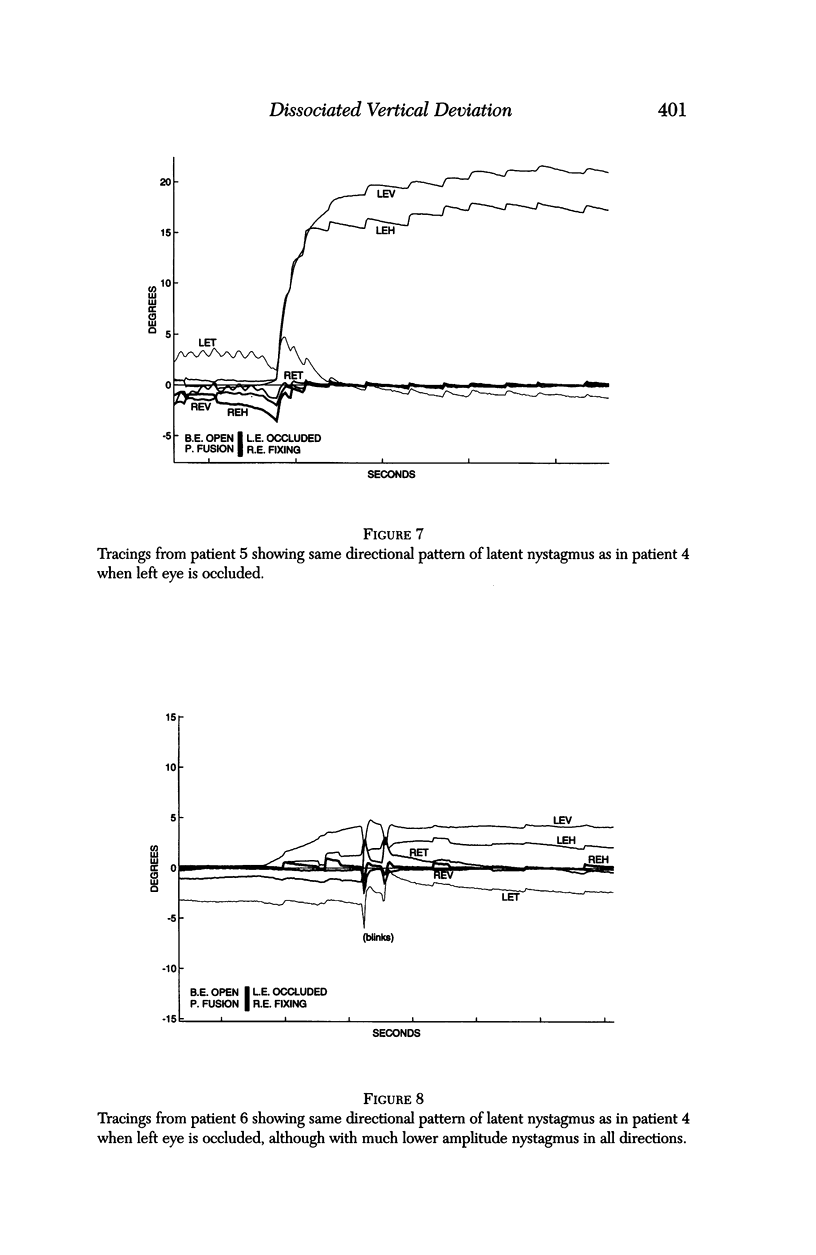
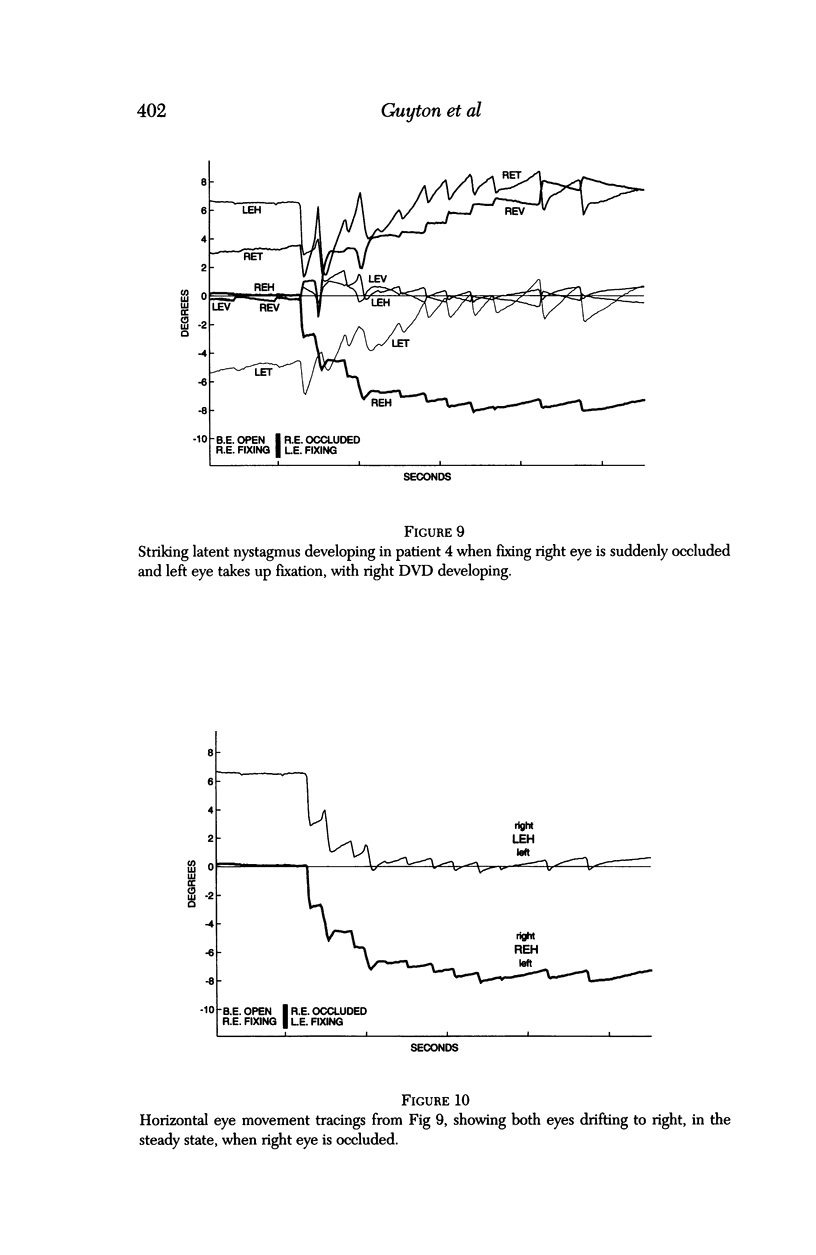
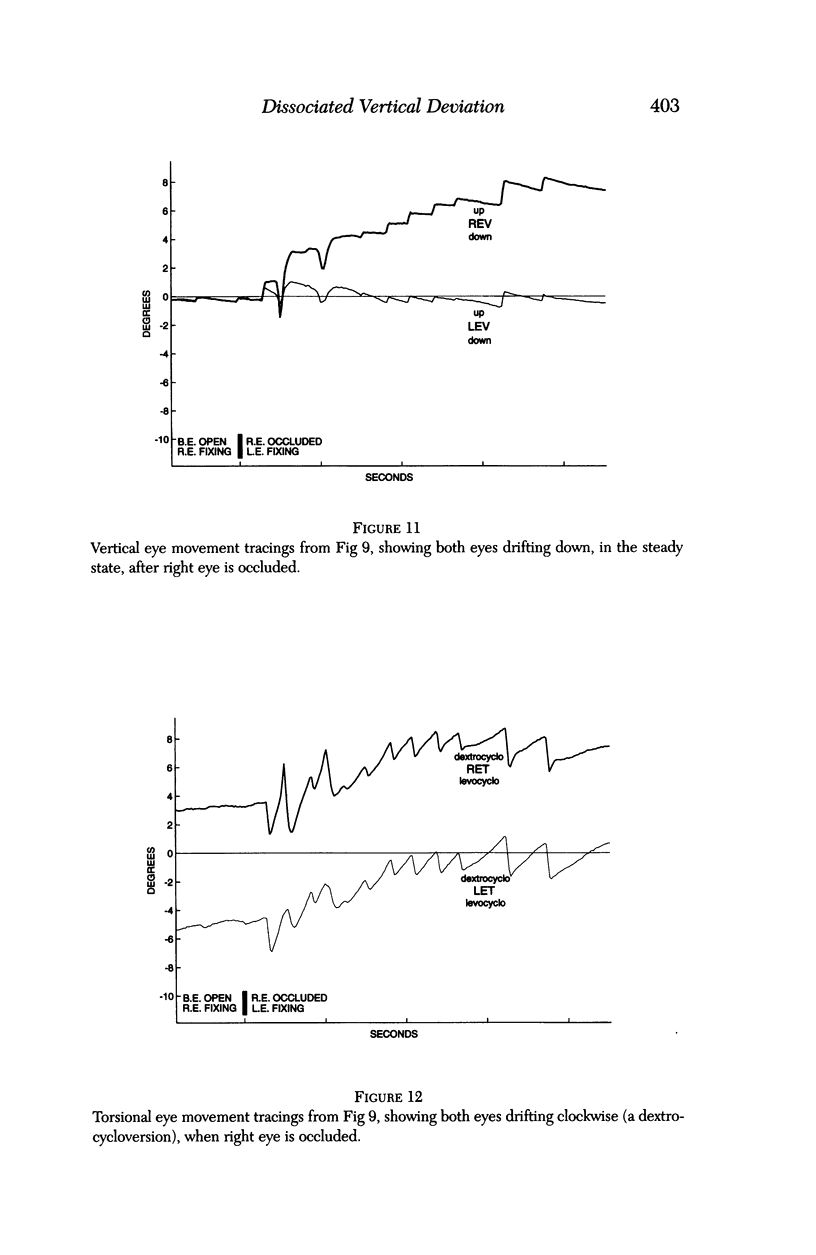
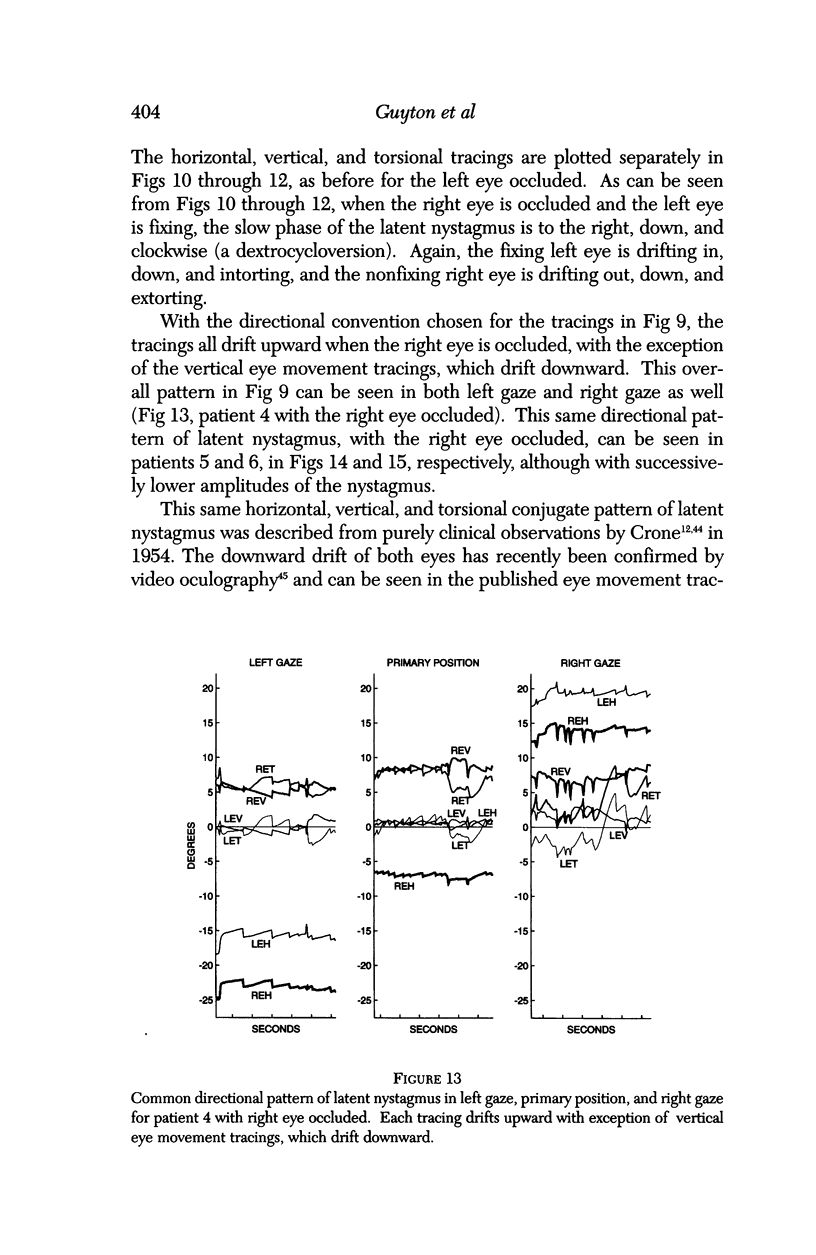
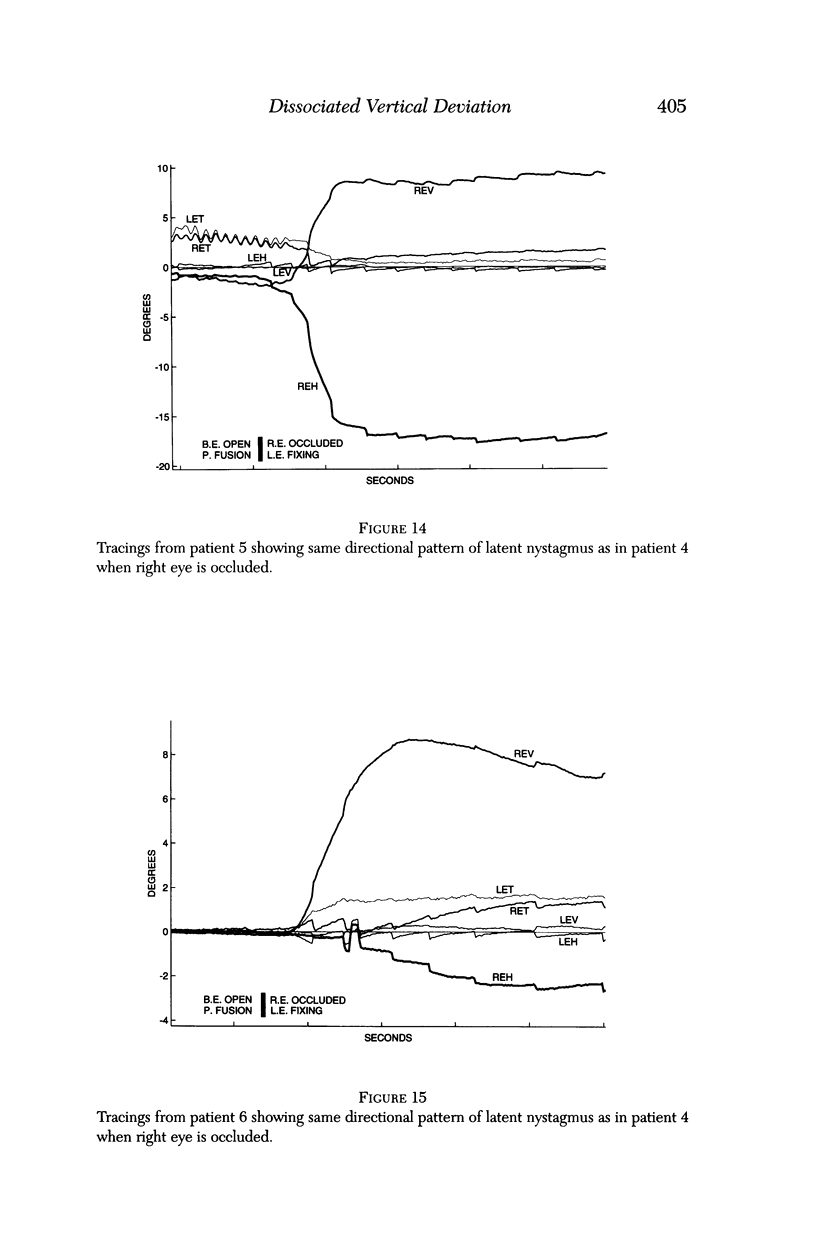
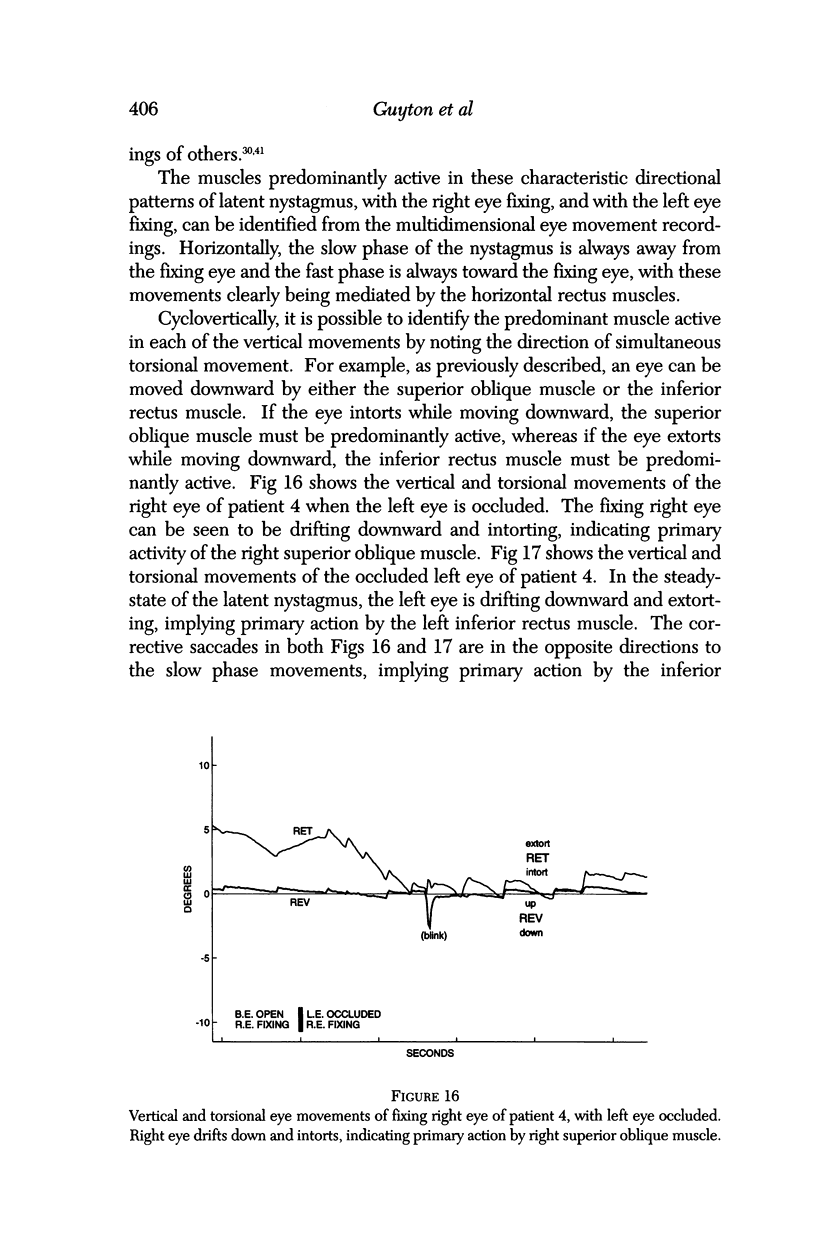
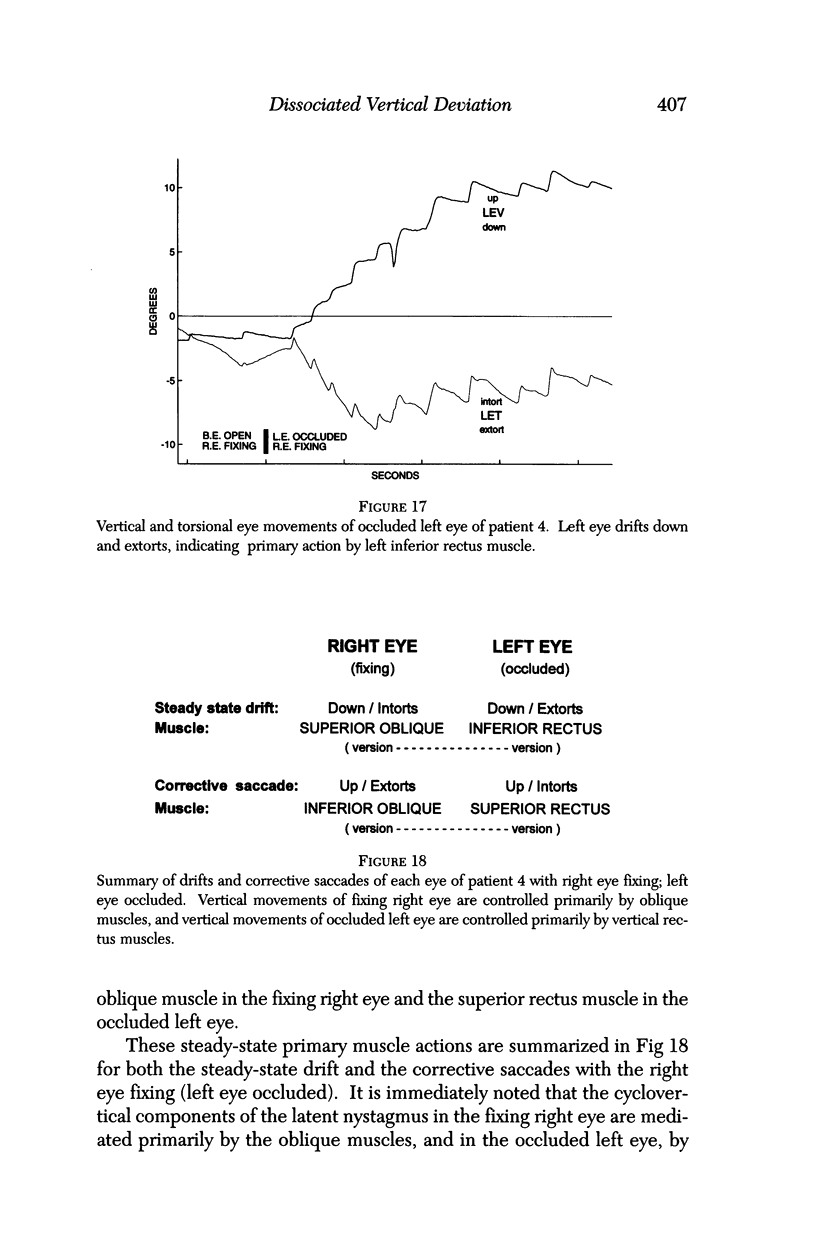

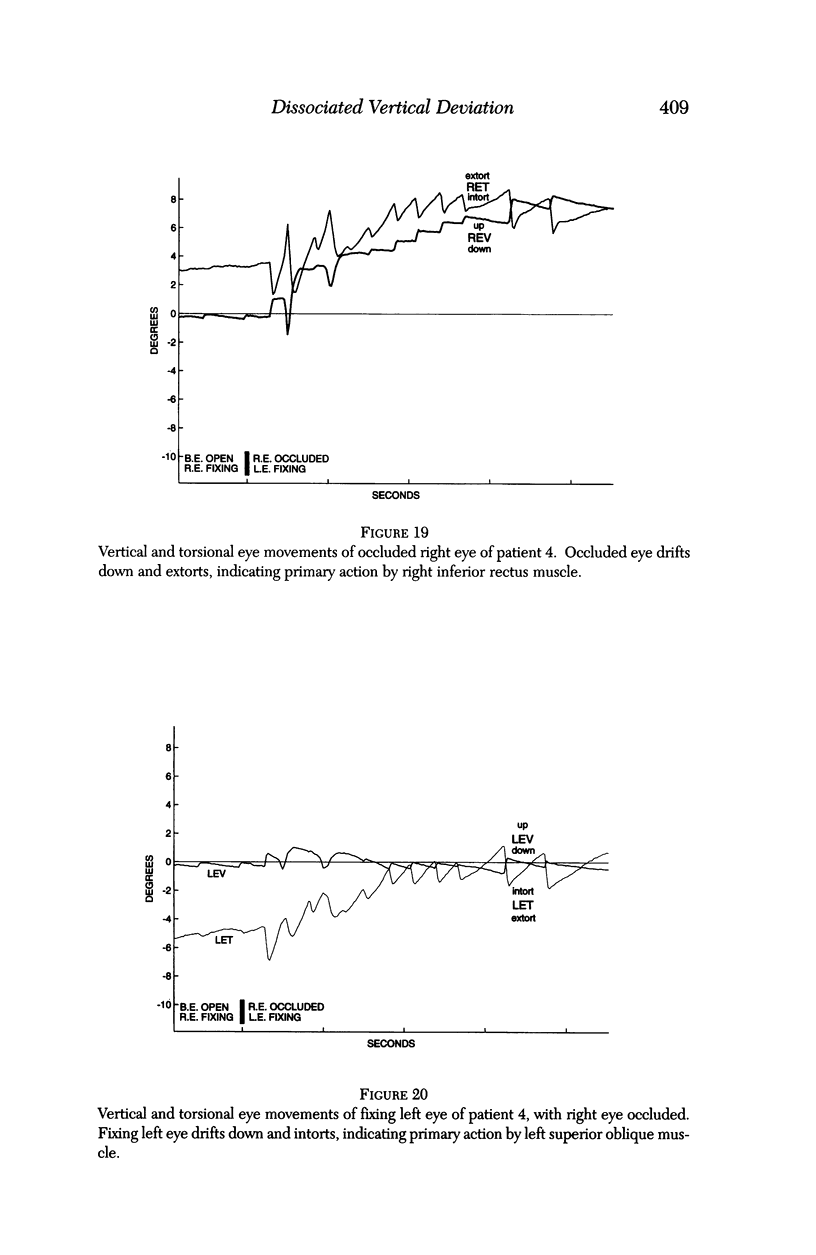
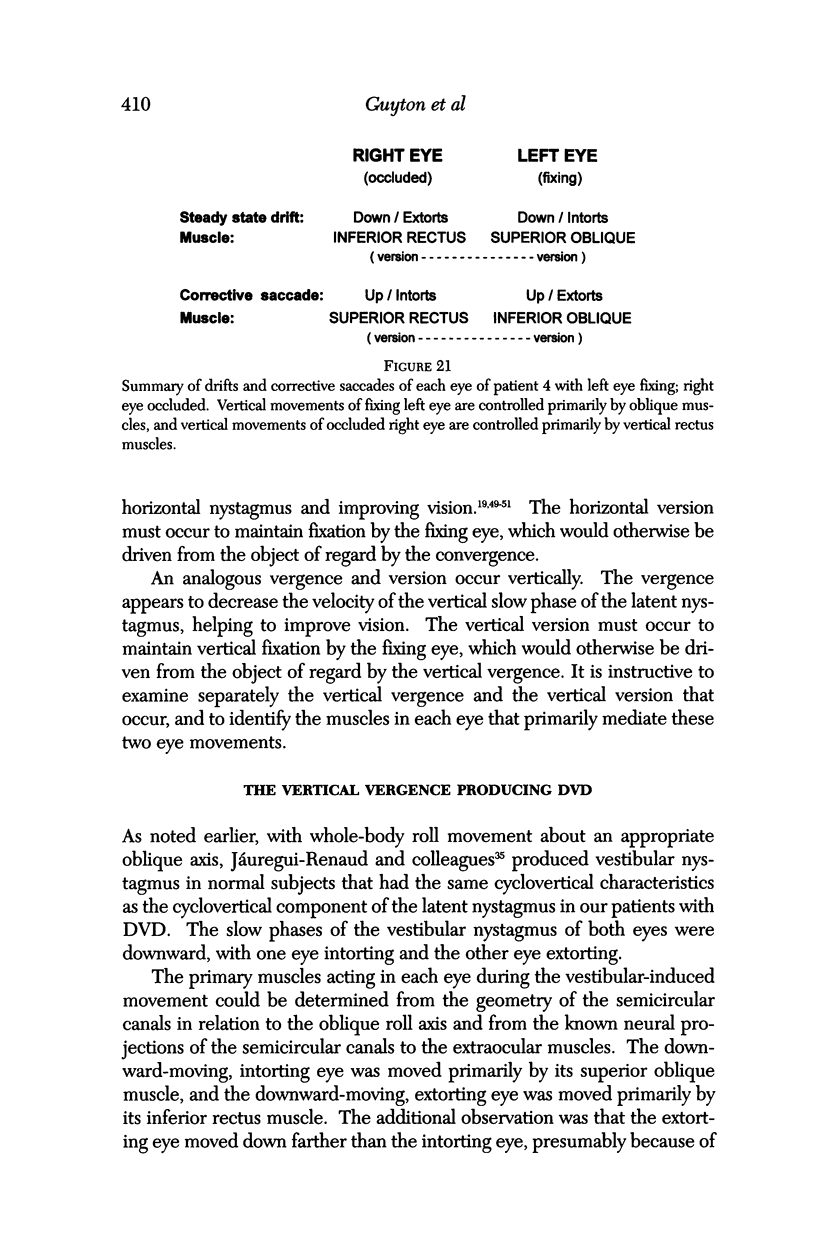
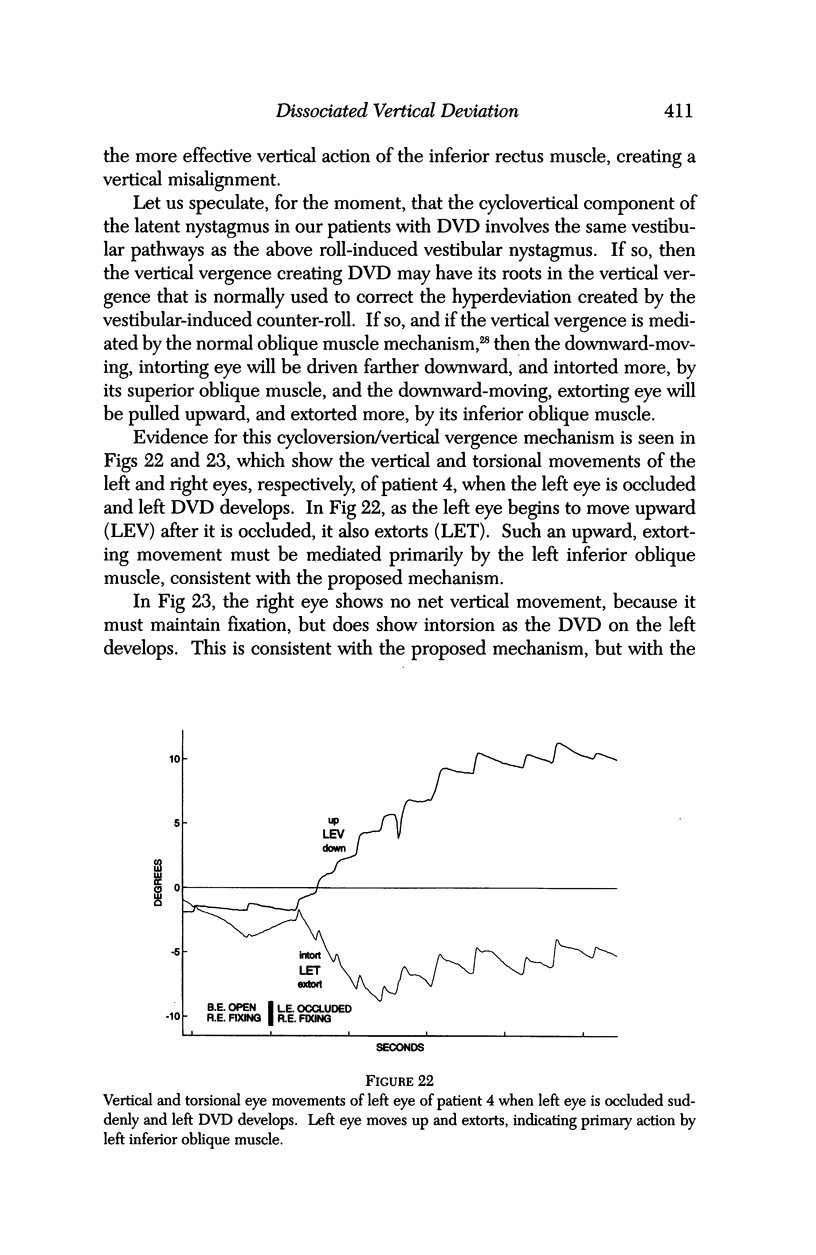
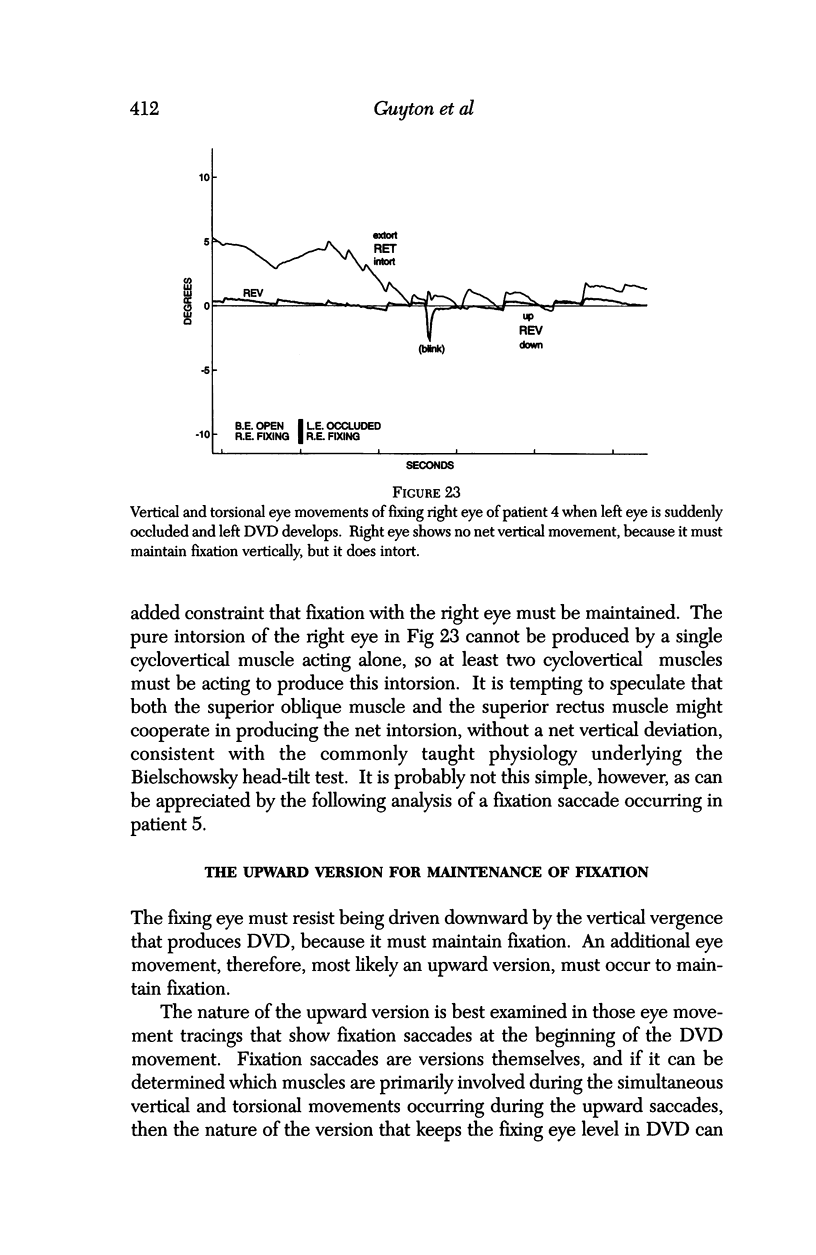
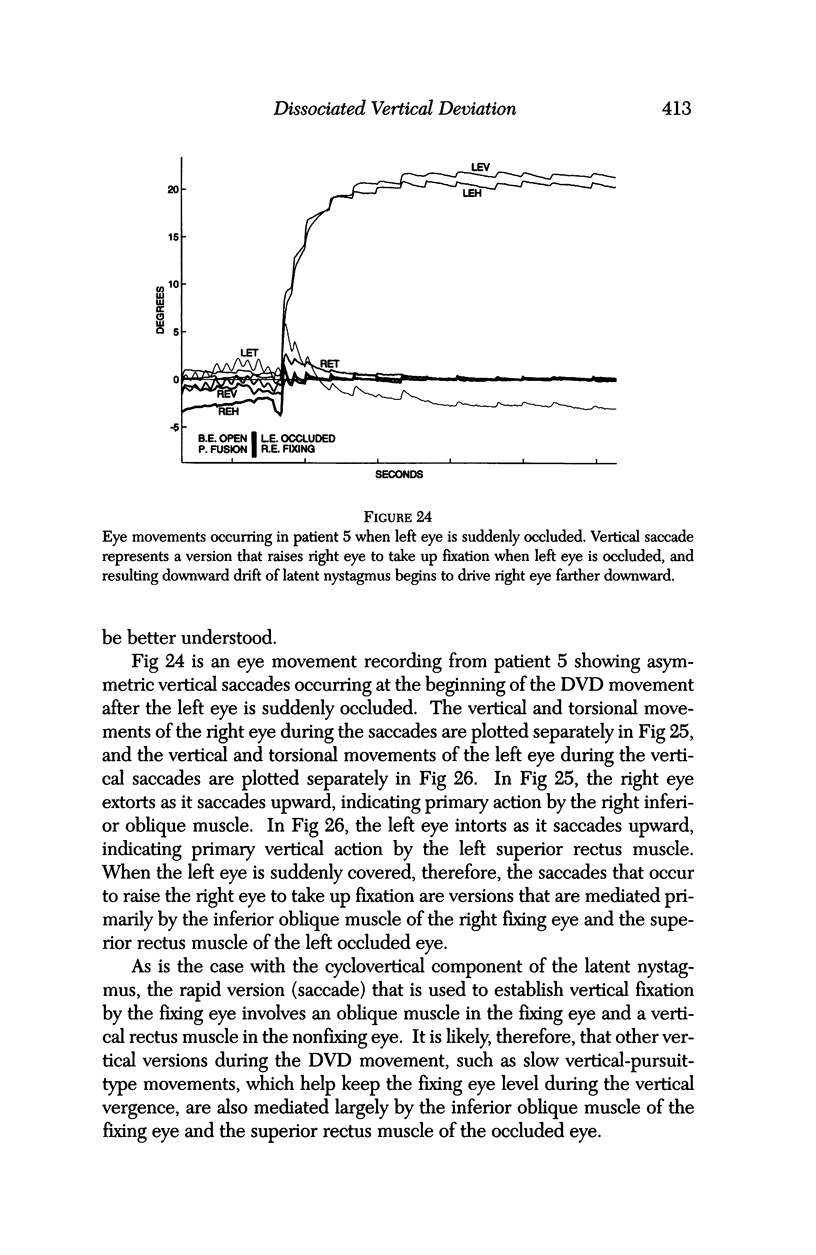
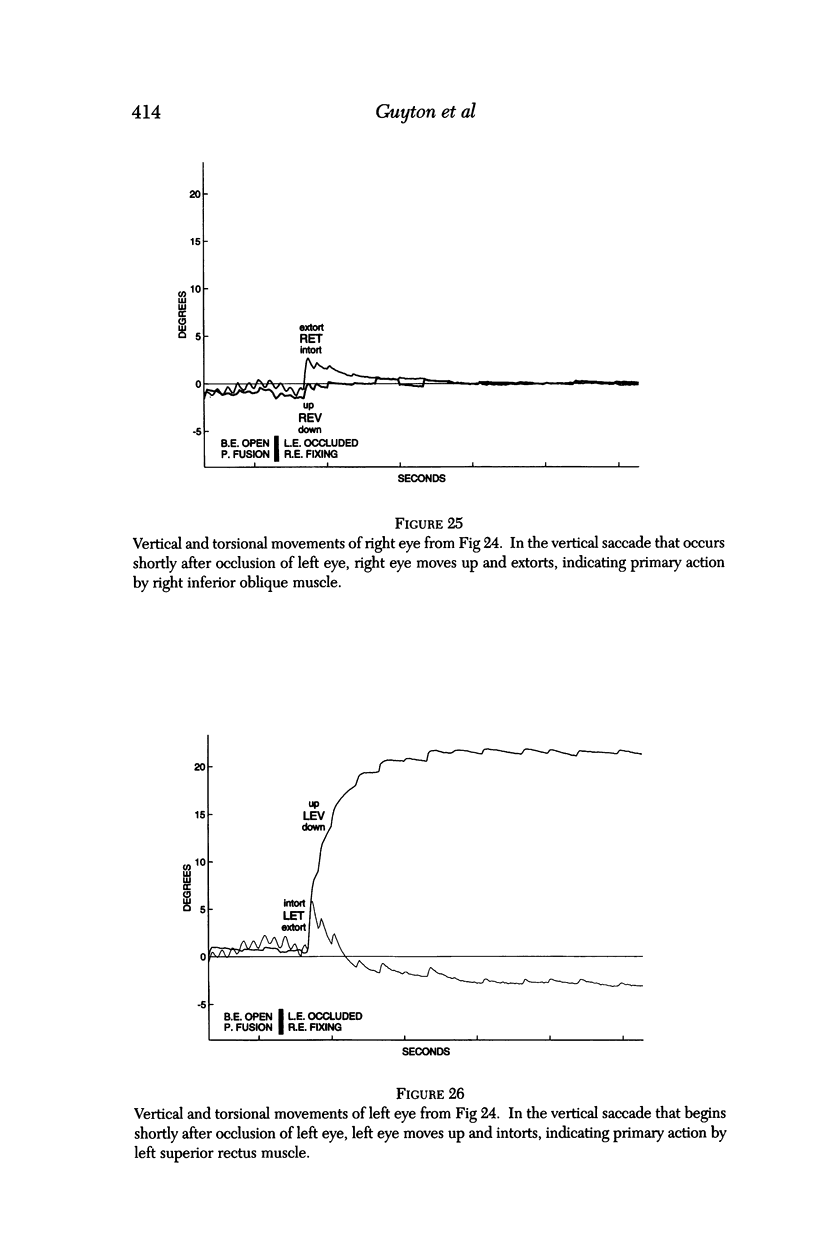
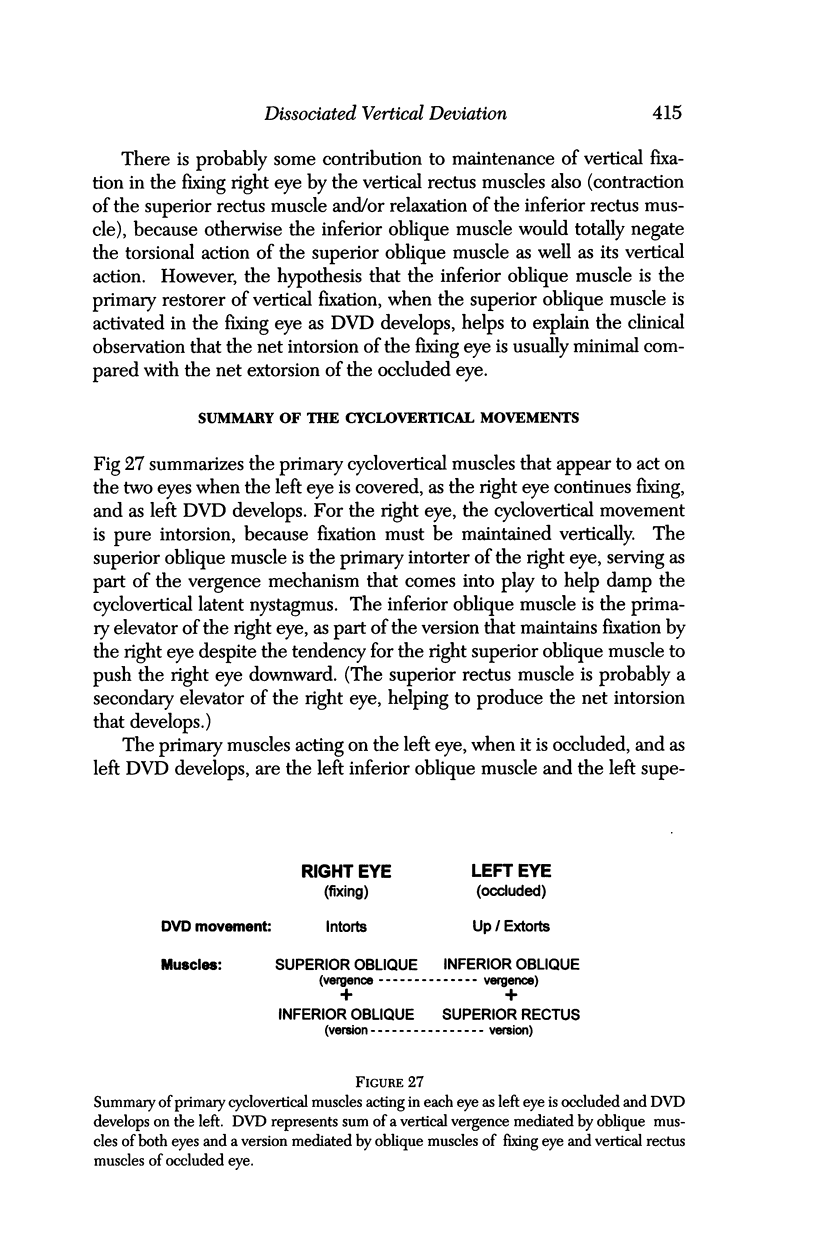
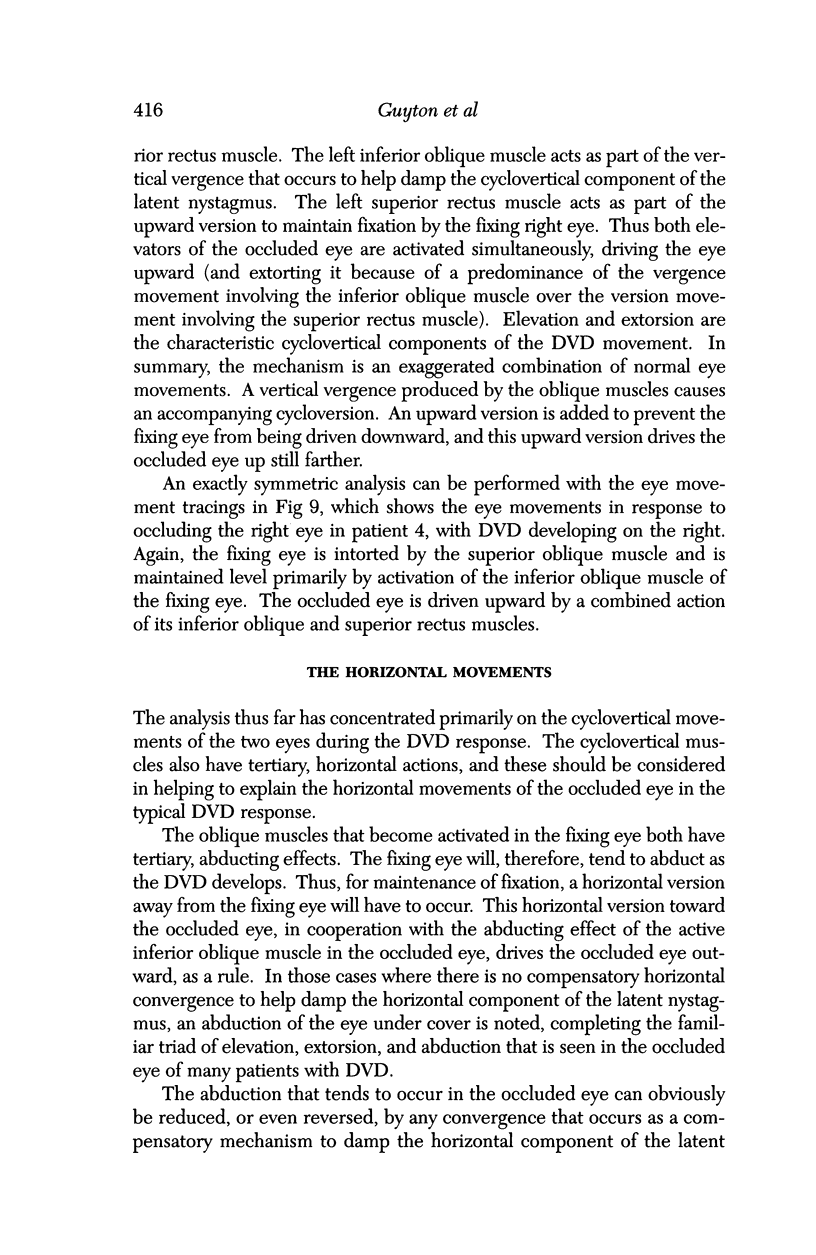
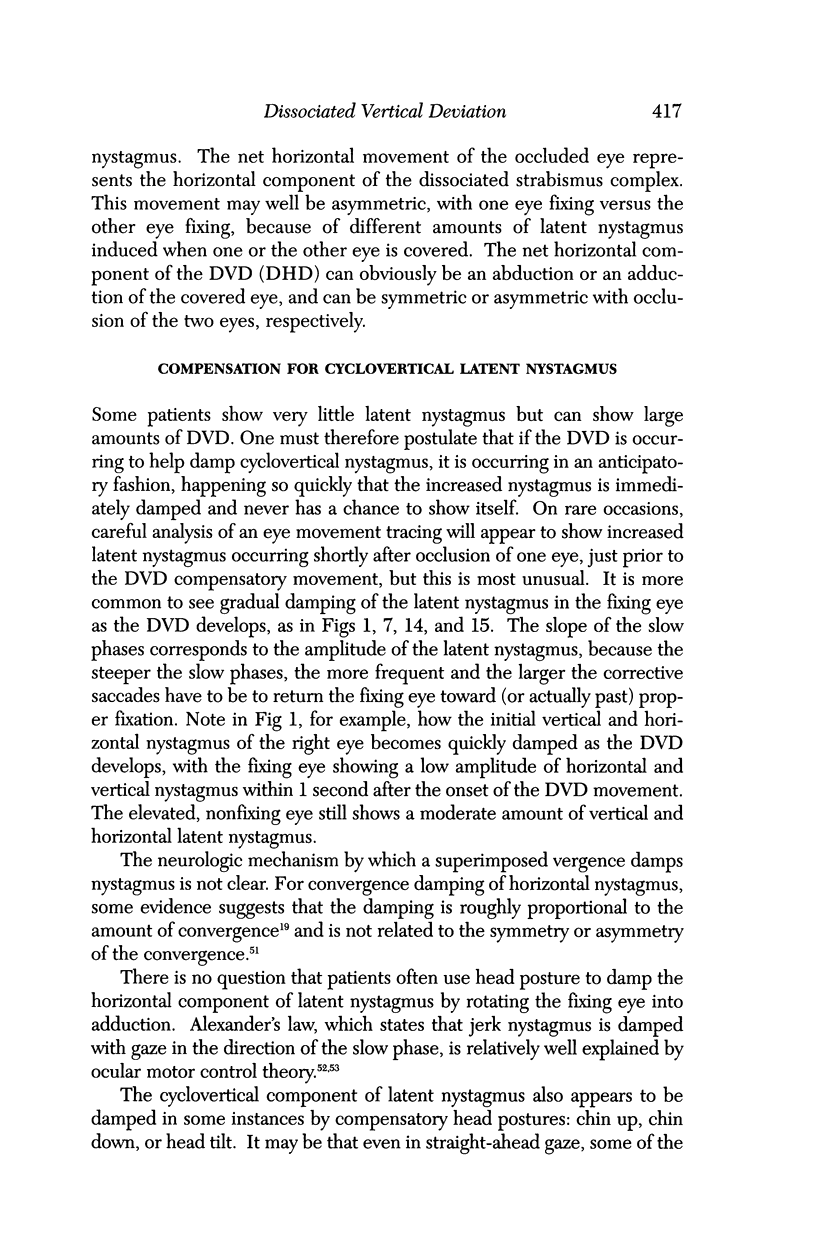
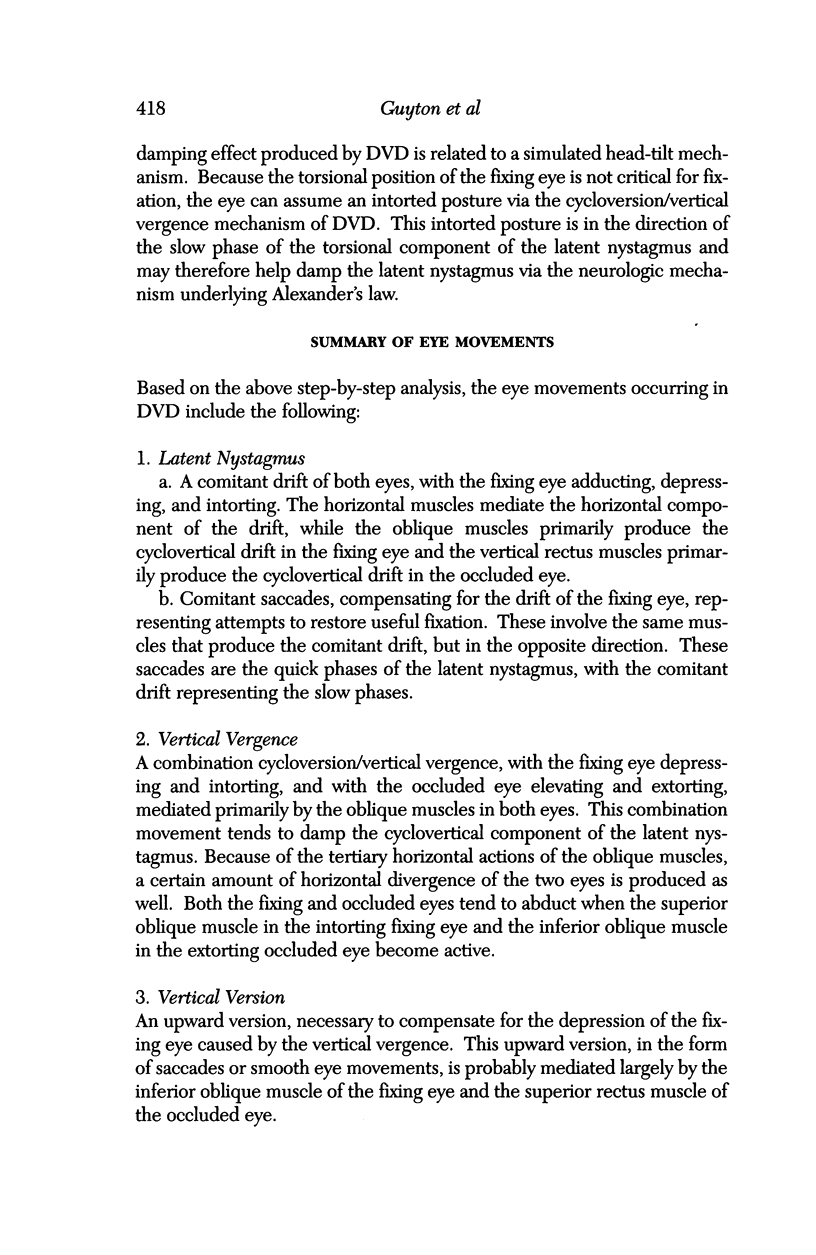
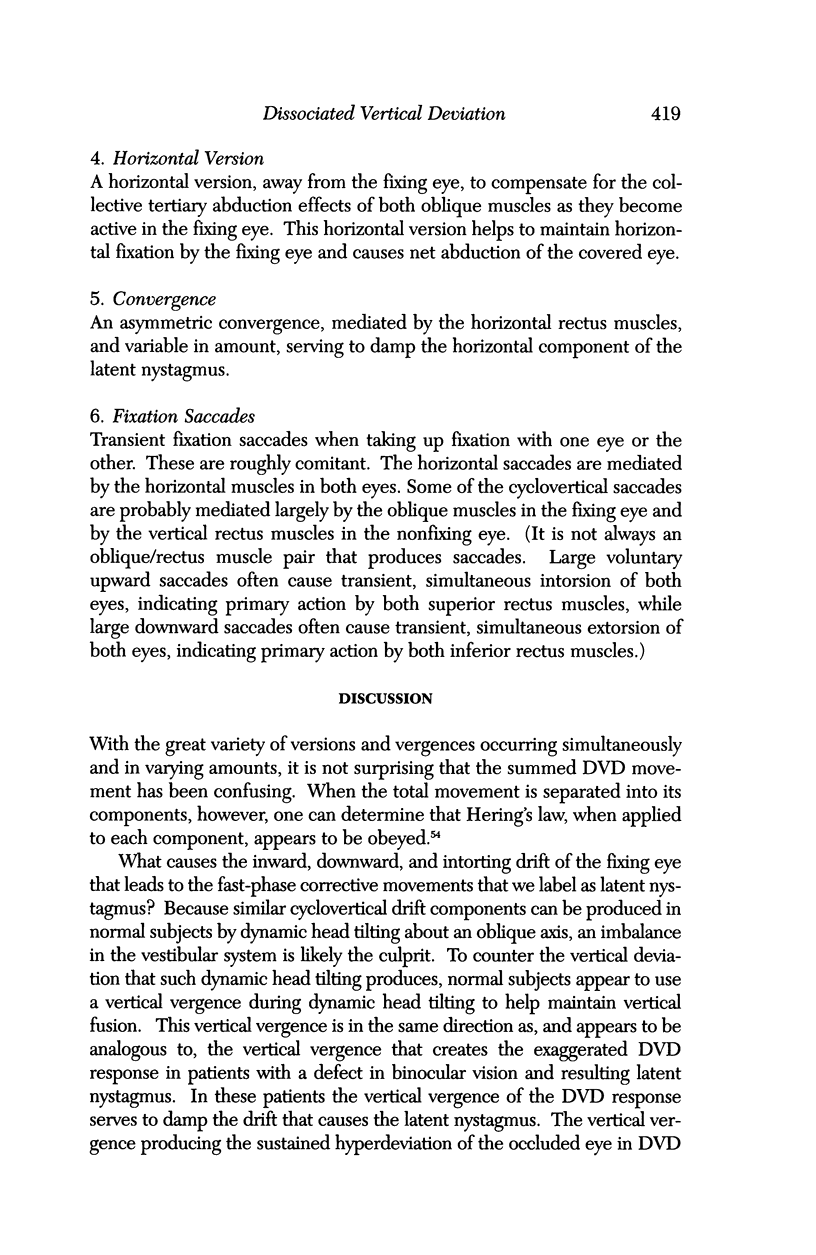
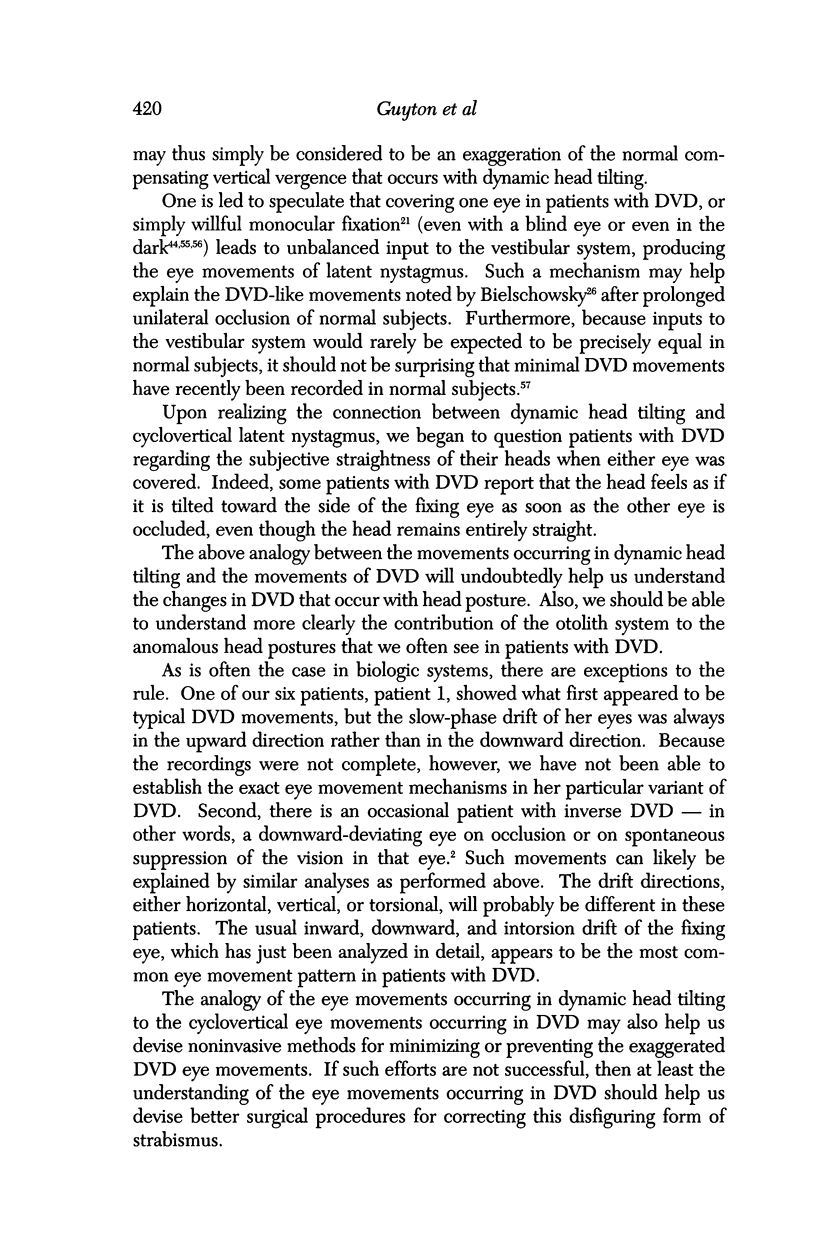
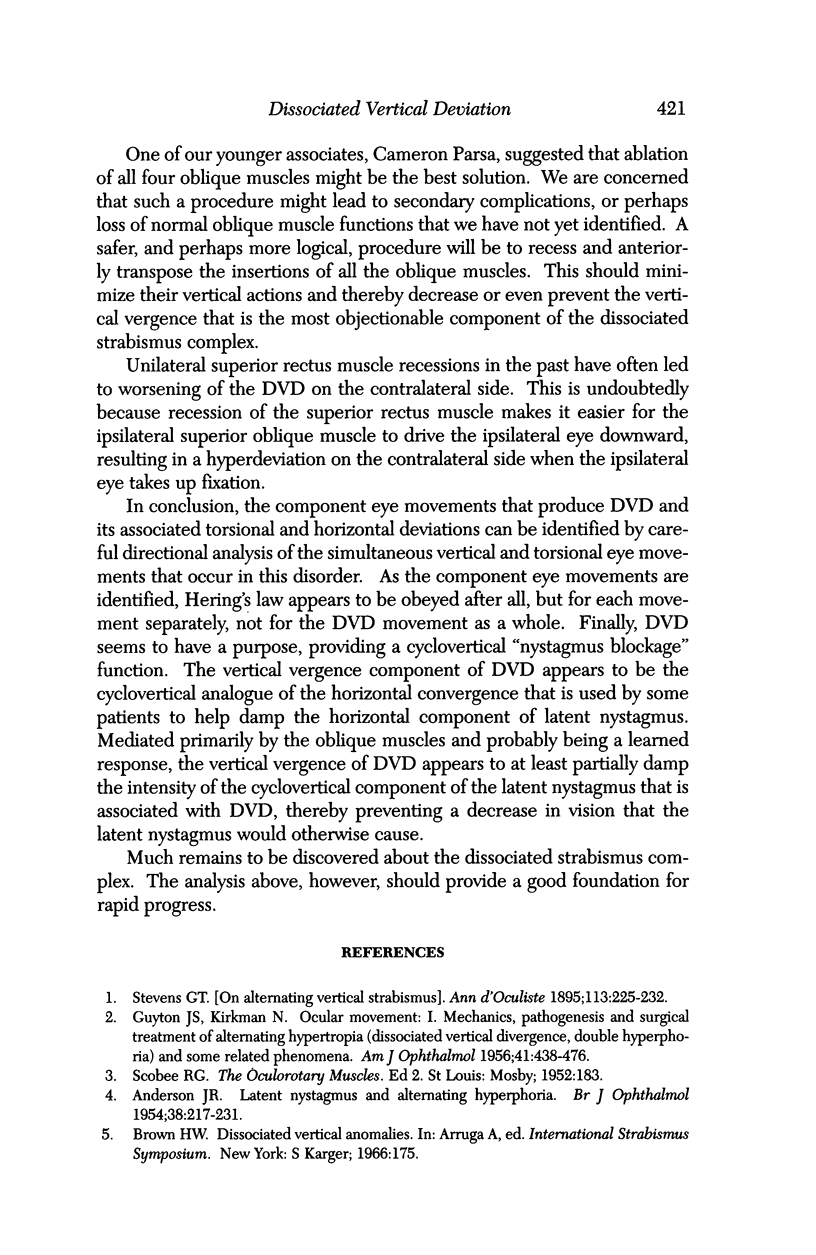
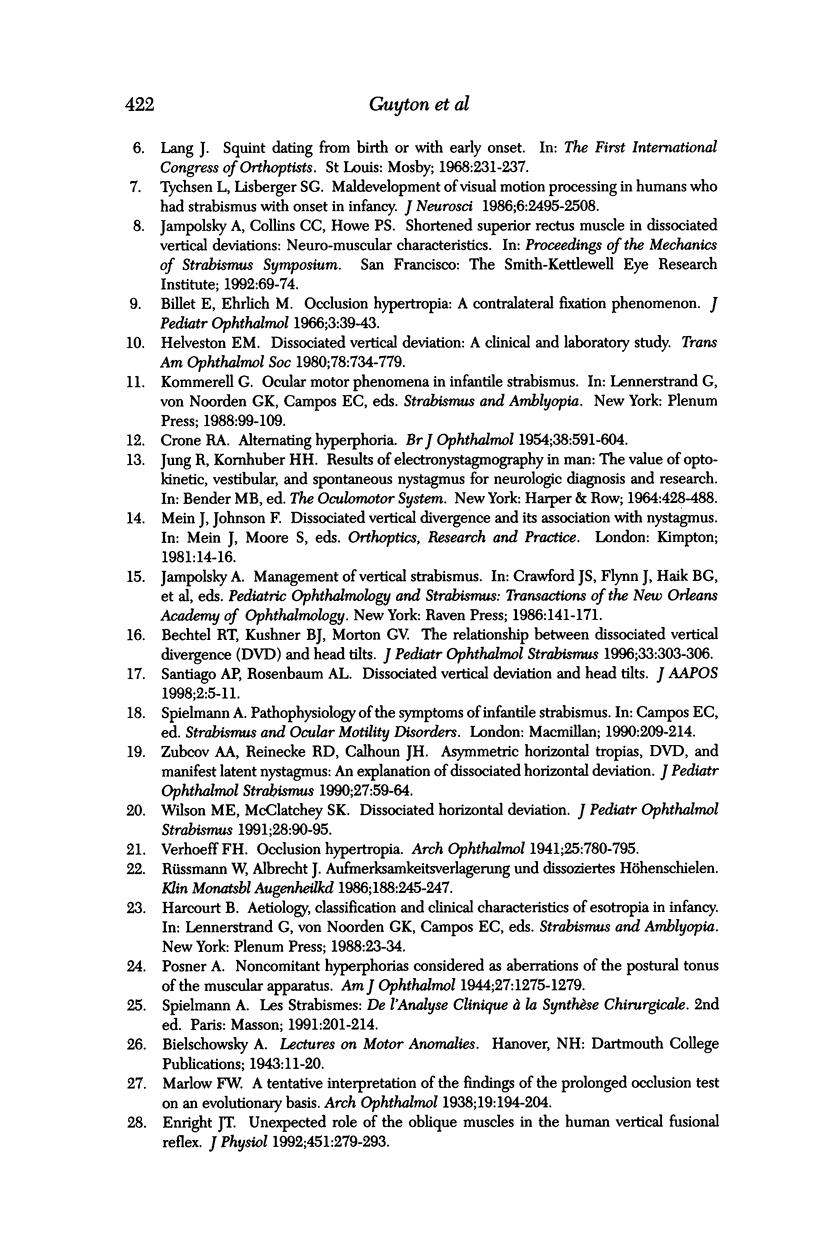
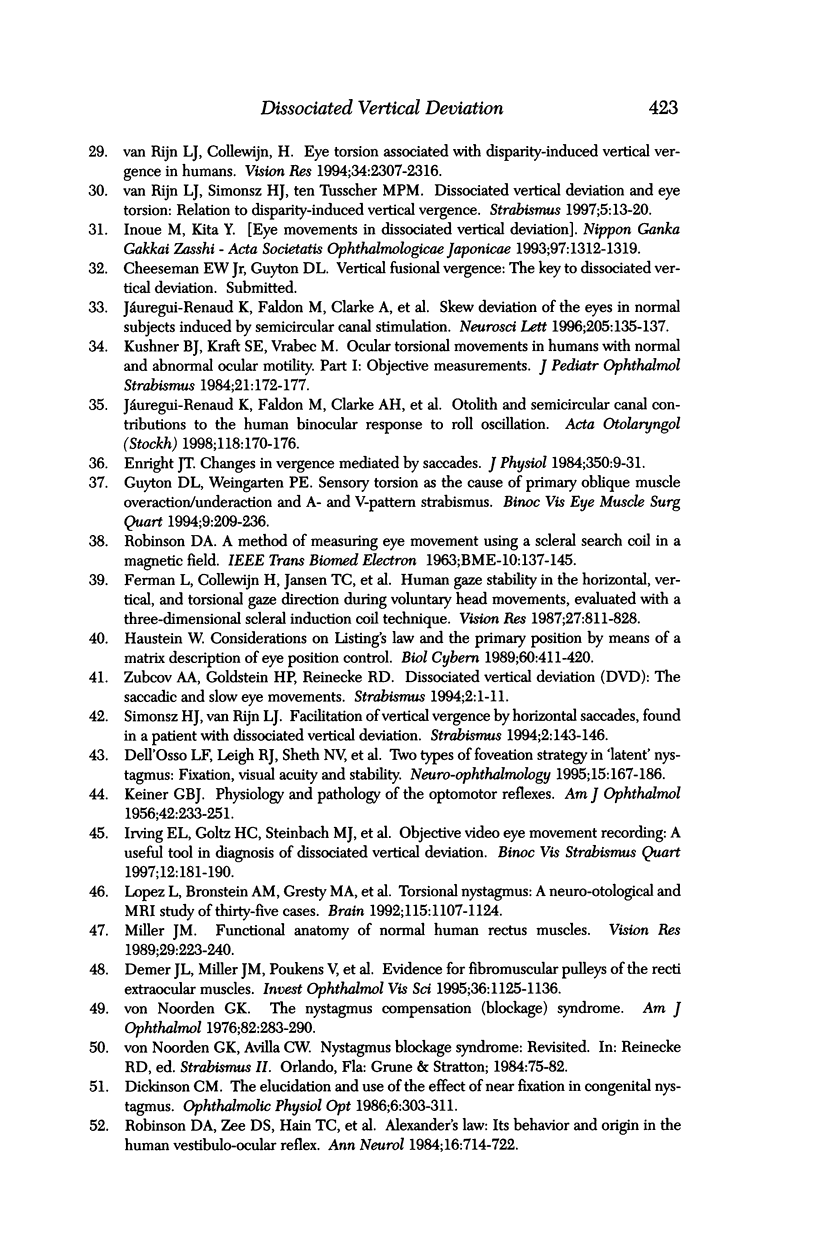
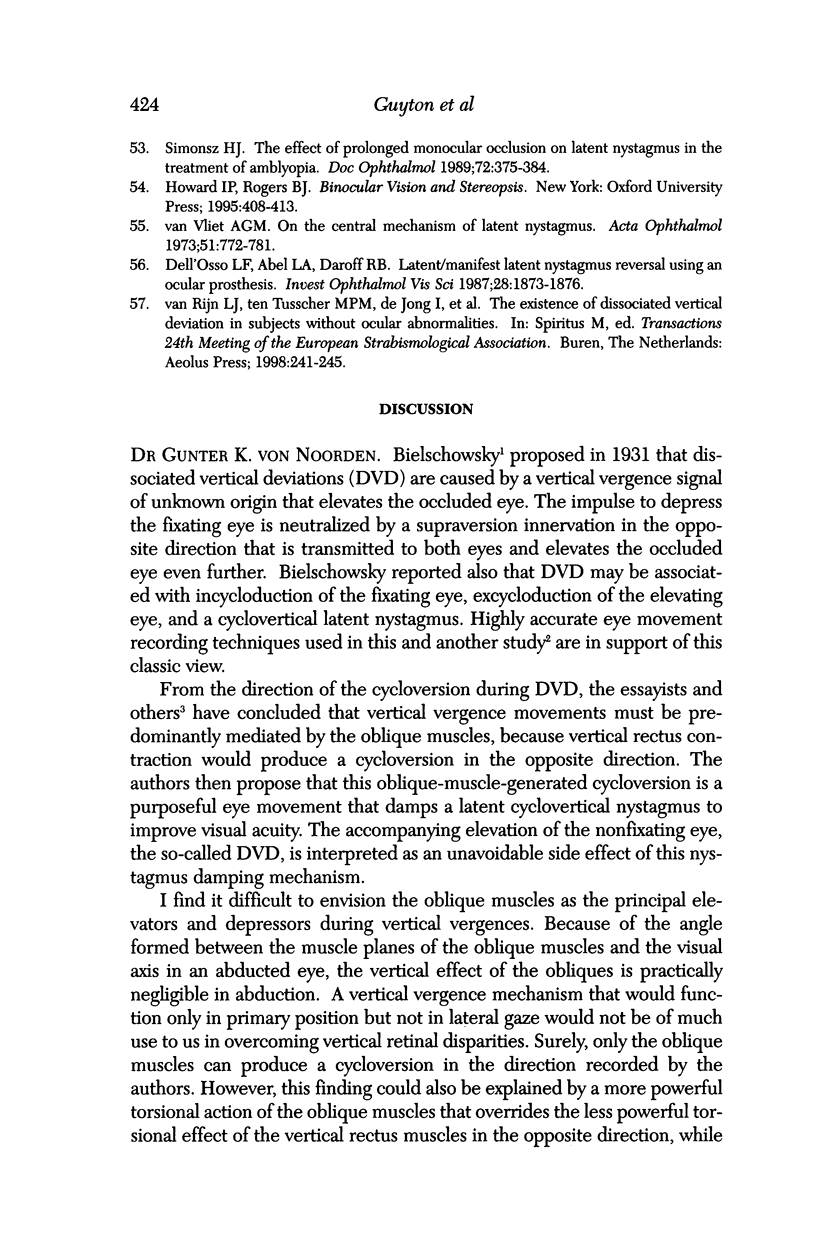
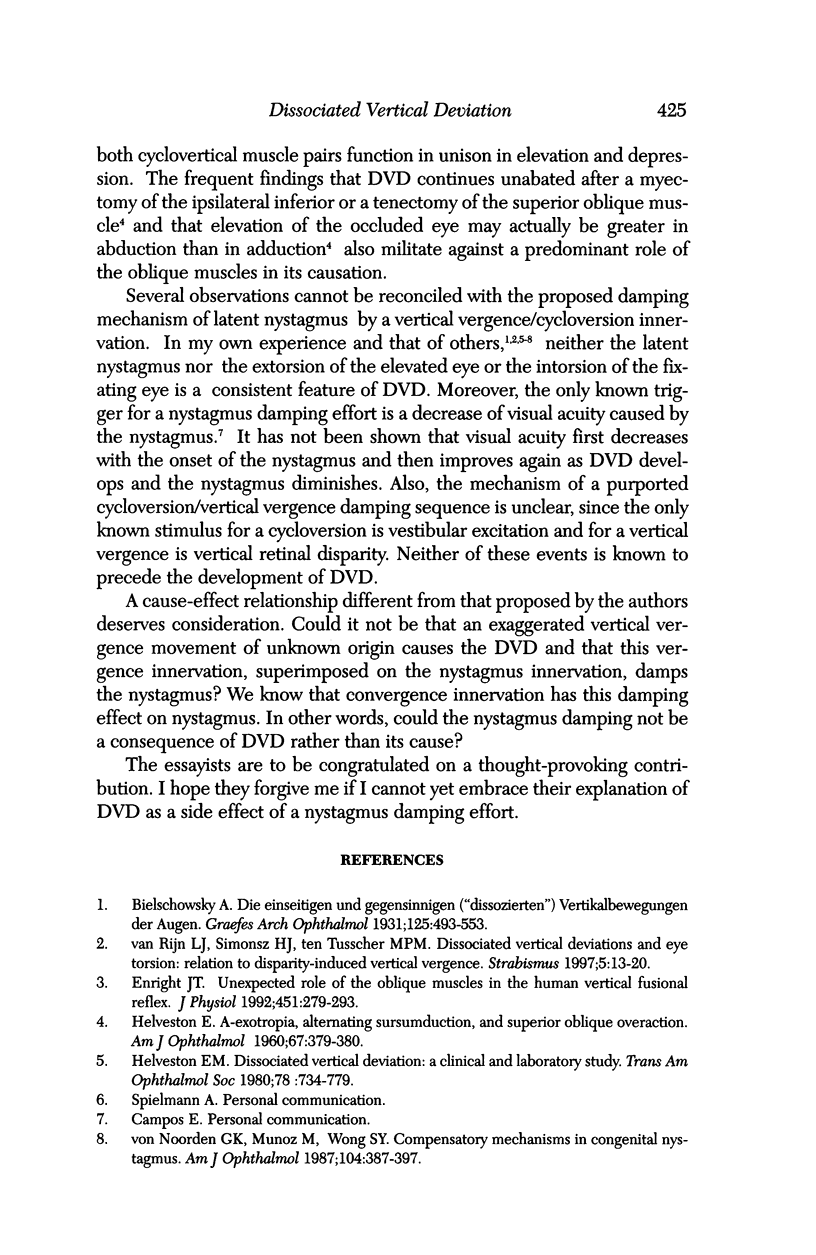
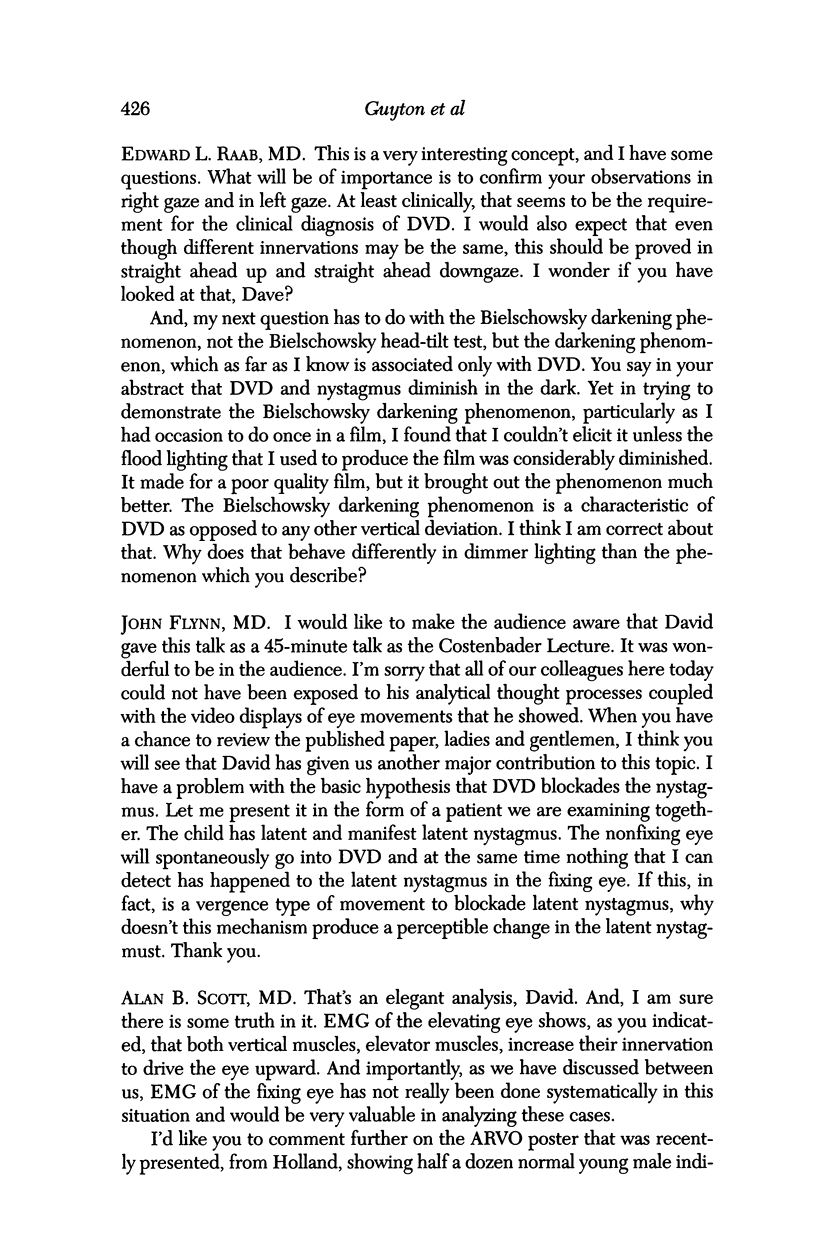
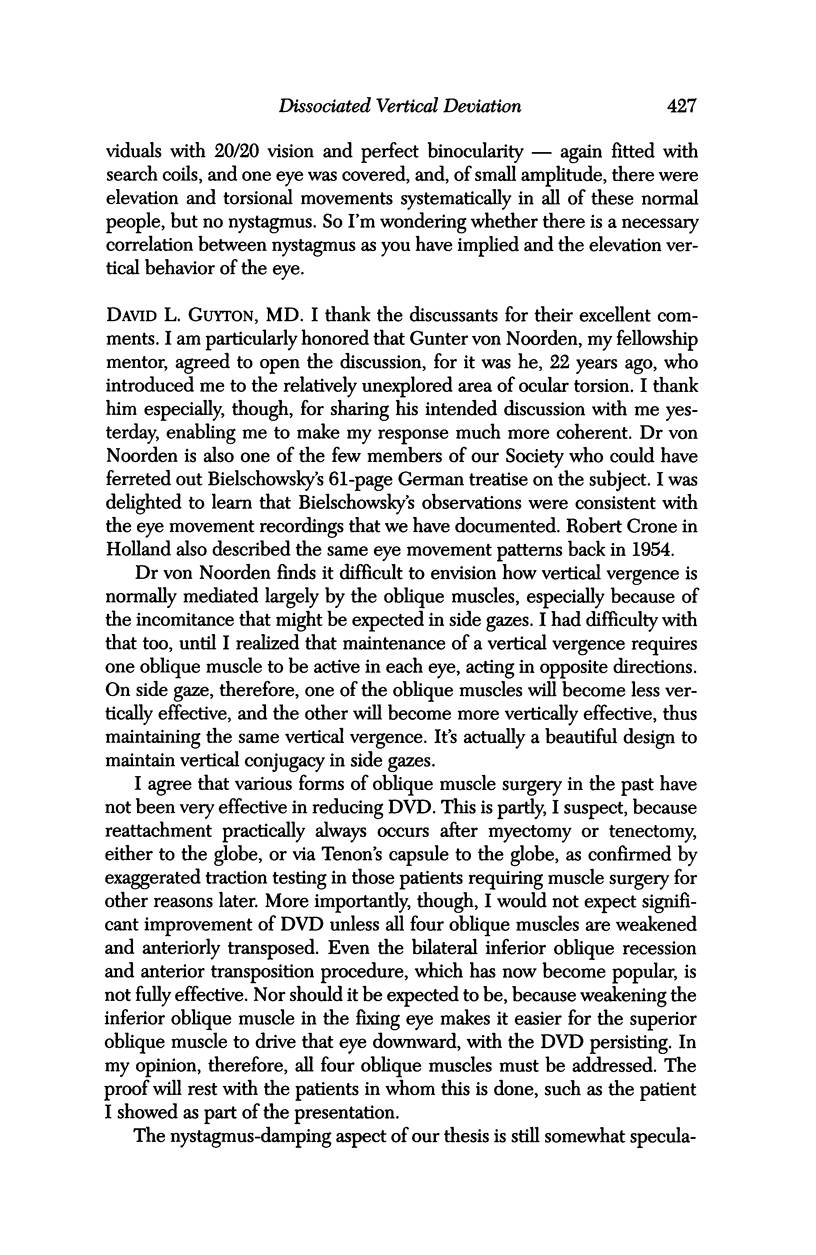

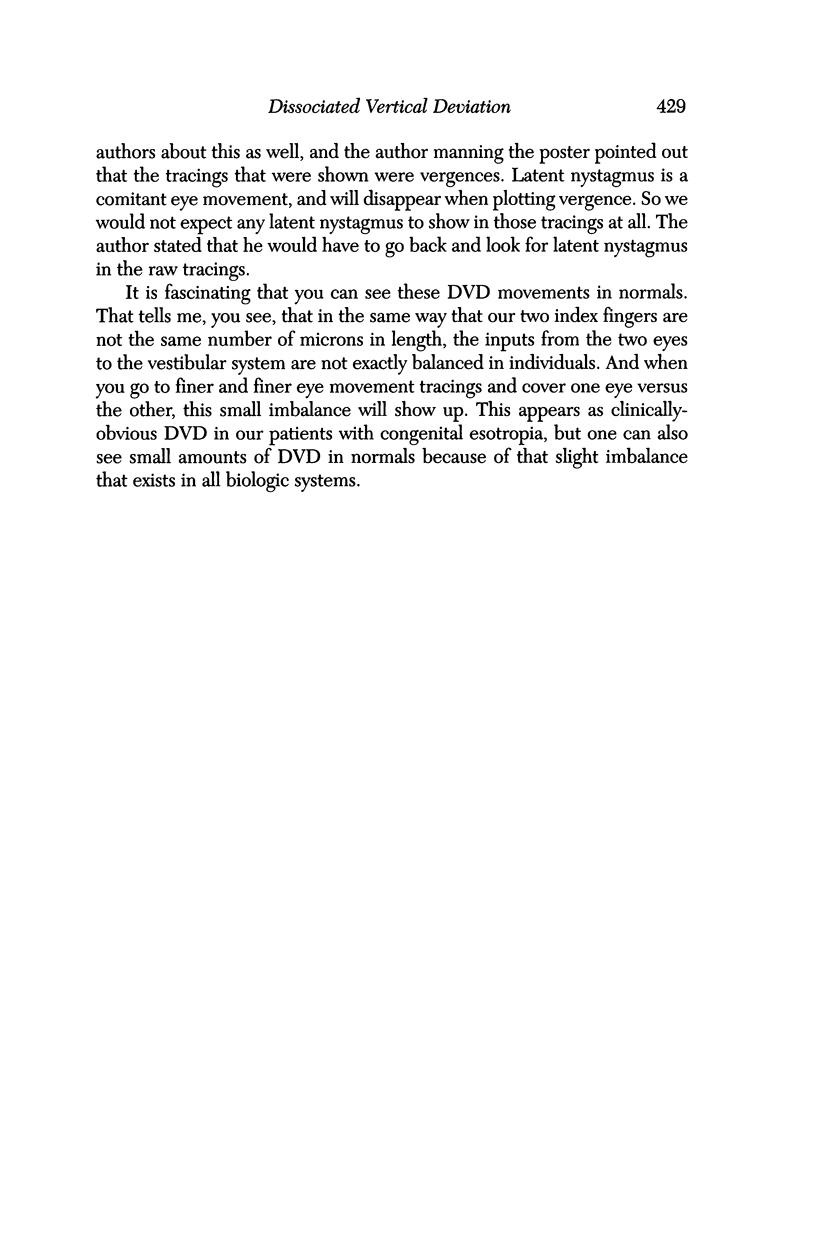
Selected References
These references are in PubMed. This may not be the complete list of references from this article.
- ANDERSON J. R. Latent nystagmus and alternating hyperphoria. Br J Ophthalmol. 1954 Apr;38(4):217–231. doi: 10.1136/bjo.38.4.217. [DOI] [PMC free article] [PubMed] [Google Scholar]
- Bechtel R. T., Kushner B. J., Morton G. V. The relationship between dissociated vertical divergence (DVD) and head tilts. J Pediatr Ophthalmol Strabismus. 1996 Nov-Dec;33(6):303–306. doi: 10.3928/0191-3913-19961101-06. [DOI] [PubMed] [Google Scholar]
- CRONE R. A. Alternating hyperphoria. Br J Ophthalmol. 1954 Oct;38(10):591–604. doi: 10.1136/bjo.38.10.591. [DOI] [PMC free article] [PubMed] [Google Scholar]
- Dell'Osso L. F., Abel L. A., Daroff R. B. Latent/manifest latent nystagmus reversal using an ocular prosthesis. Implications for vision and ocular dominance. Invest Ophthalmol Vis Sci. 1987 Nov;28(11):1873–1876. [PubMed] [Google Scholar]
- Dell'Osso L. F., Leigh R. J., Sheth N. V., Daroff R. B. Two types of foveation strategy in 'latent' nystagmus: fixation, visual acuity and stability. Neuroophthalmology. 1995 Aug;15(4):167–186. doi: 10.3109/01658109509044600. [DOI] [PubMed] [Google Scholar]
- Demer J. L., Miller J. M., Poukens V., Vinters H. V., Glasgow B. J. Evidence for fibromuscular pulleys of the recti extraocular muscles. Invest Ophthalmol Vis Sci. 1995 May;36(6):1125–1136. [PubMed] [Google Scholar]
- Dickinson C. M. The elucidation and use of the effect of near fixation in congenital nystagmus. Ophthalmic Physiol Opt. 1986;6(3):303–311. [PubMed] [Google Scholar]
- Enright J. T. Changes in vergence mediated by saccades. J Physiol. 1984 May;350:9–31. doi: 10.1113/jphysiol.1984.sp015186. [DOI] [PMC free article] [PubMed] [Google Scholar]
- Enright J. T. Unexpected role of the oblique muscles in the human vertical fusional reflex. J Physiol. 1992;451:279–293. doi: 10.1113/jphysiol.1992.sp019164. [DOI] [PMC free article] [PubMed] [Google Scholar]
- Enright J. T. Unexpected role of the oblique muscles in the human vertical fusional reflex. J Physiol. 1992;451:279–293. doi: 10.1113/jphysiol.1992.sp019164. [DOI] [PMC free article] [PubMed] [Google Scholar]
- Ferman L., Collewijn H., Jansen T. C., Van den Berg A. V. Human gaze stability in the horizontal, vertical and torsional direction during voluntary head movements, evaluated with a three-dimensional scleral induction coil technique. Vision Res. 1987;27(5):811–828. doi: 10.1016/0042-6989(87)90078-2. [DOI] [PubMed] [Google Scholar]
- GUYTON J. S., KIRKMAN N. Ocular movement. I. Mechanics, pathogenesis and surgical treatment of alternating hypertropia (dissociated vertical divergence, double hypertropia) and some related phenomena. Am J Ophthalmol. 1956 Mar;41(3):438–476. [PubMed] [Google Scholar]
- Haustein W. Considerations on Listing's Law and the primary position by means of a matrix description of eye position control. Biol Cybern. 1989;60(6):411–420. doi: 10.1007/BF00204696. [DOI] [PubMed] [Google Scholar]
- Helveston E. M. A-exotropia, alternating sursumduction, and superior oblique overaction. Am J Ophthalmol. 1969 Mar;67(3):377–380. doi: 10.1016/0002-9394(69)92049-2. [DOI] [PubMed] [Google Scholar]
- Helveston E. M. Dissociated vertical deviation-a clinical and laboratory study. Trans Am Ophthalmol Soc. 1980;78:734–779. [PMC free article] [PubMed] [Google Scholar]
- Helveston E. M. Dissociated vertical deviation-a clinical and laboratory study. Trans Am Ophthalmol Soc. 1980;78:734–779. [PMC free article] [PubMed] [Google Scholar]
- Inoue M., Kita Y. [Eye movements in dissociated vertical deviation]. Nippon Ganka Gakkai Zasshi. 1993 Nov;97(11):1312–1319. [PubMed] [Google Scholar]
- Jauregui-Renaud K., Faldon M., Clarke A., Bronstein A. M., Gresty M. A. Skew deviation of the eyes in normal human subjects induced by semicircular canal stimulation. Neurosci Lett. 1996 Feb 23;205(2):135–137. doi: 10.1016/0304-3940(96)12372-7. [DOI] [PubMed] [Google Scholar]
- Jáuregui-Renaud K., Faldon M., Clarke A. H., Bronstein A. M., Gresty M. A. Otolith and semicircular canal contributions to the human binocular response to roll oscillation. Acta Otolaryngol. 1998 Mar;118(2):170–176. doi: 10.1080/00016489850154865. [DOI] [PubMed] [Google Scholar]
- KEINER G. B. Physiology and pathology of the optomotor reflexes. Am J Ophthalmol. 1956 Aug;42(2):233–251. doi: 10.1016/0002-9394(56)90927-8. [DOI] [PubMed] [Google Scholar]
- Kushner B. J., Kraft S. E., Vrabec M. Ocular torsional movements in humans with normal and abnormal ocular motility--Part I: Objective measurements. J Pediatr Ophthalmol Strabismus. 1984 Sep-Oct;21(5):172–177. doi: 10.3928/0191-3913-19840901-05. [DOI] [PubMed] [Google Scholar]
- Lopez L., Bronstein A. M., Gresty M. A., Rudge P., du Boulay E. P. Torsional nystagmus. A neuro-otological and MRI study of thirty-five cases. Brain. 1992 Aug;115(Pt 4):1107–1124. doi: 10.1093/brain/115.4.1107. [DOI] [PubMed] [Google Scholar]
- Miller J. M. Functional anatomy of normal human rectus muscles. Vision Res. 1989;29(2):223–240. doi: 10.1016/0042-6989(89)90126-0. [DOI] [PubMed] [Google Scholar]
- ROBINSON D. A. A METHOD OF MEASURING EYE MOVEMENT USING A SCLERAL SEARCH COIL IN A MAGNETIC FIELD. IEEE Trans Biomed Eng. 1963 Oct;10:137–145. doi: 10.1109/tbmel.1963.4322822. [DOI] [PubMed] [Google Scholar]
- Robinson D. A., Zee D. S., Hain T. C., Holmes A., Rosenberg L. F. Alexander's law: its behavior and origin in the human vestibulo-ocular reflex. Ann Neurol. 1984 Dec;16(6):714–722. doi: 10.1002/ana.410160614. [DOI] [PubMed] [Google Scholar]
- Rüssmann W., Albrecht J. Aufmerksamkeitsverlagerung und dissoziiertes Höhenschielen. Klin Monbl Augenheilkd. 1986 Mar;188(3):245–247. doi: 10.1055/s-2008-1050622. [DOI] [PubMed] [Google Scholar]
- Santiago A. P., Rosenbaum A. L. Dissociated vertical deviation and head tilts. J AAPOS. 1998 Feb;2(1):5–11. doi: 10.1016/s1091-8531(98)90103-3. [DOI] [PubMed] [Google Scholar]
- Simonsz H. J. The effect of prolonged monocular occlusion on latent nystagmus in the treatment of amblyopia. Doc Ophthalmol. 1989 Aug;72(3-4):375–384. doi: 10.1007/BF00153506. [DOI] [PubMed] [Google Scholar]
- Tychsen L., Lisberger S. G. Maldevelopment of visual motion processing in humans who had strabismus with onset in infancy. J Neurosci. 1986 Sep;6(9):2495–2508. doi: 10.1523/JNEUROSCI.06-09-02495.1986. [DOI] [PMC free article] [PubMed] [Google Scholar]
- Van Rijn L. J., Collewijn H. Eye torsion associated with disparity-induced vertical vergence in humans. Vision Res. 1994 Sep;34(17):2307–2316. doi: 10.1016/0042-6989(94)90109-0. [DOI] [PubMed] [Google Scholar]
- Wilson M. E., McClatchey S. K. Dissociated horizontal deviation. J Pediatr Ophthalmol Strabismus. 1991 Mar-Apr;28(2):90–95. doi: 10.3928/0191-3913-19910301-09. [DOI] [PubMed] [Google Scholar]
- Zubcov A. A., Reinecke R. D., Calhoun J. H. Asymmetric horizontal tropias, DVD, and manifest latent nystagmus: an explanation of dissociated horizontal deviation. J Pediatr Ophthalmol Strabismus. 1990 Mar-Apr;27(2):59–65. doi: 10.3928/0191-3913-19900301-03. [DOI] [PubMed] [Google Scholar]
- van Vliet A. G. On the central mechanism of latent nystagmus. Acta Ophthalmol (Copenh) 1973;51(6):772–781. doi: 10.1111/j.1755-3768.1973.tb06046.x. [DOI] [PubMed] [Google Scholar]
- von Noorden G. K., Munoz M., Wong S. Y. Compensatory mechanisms in congenital nystagmus. Am J Ophthalmol. 1987 Oct 15;104(4):387–397. doi: 10.1016/0002-9394(87)90229-7. [DOI] [PubMed] [Google Scholar]
- von Noorden G. K. The nystagmus compensation (blockage) syndrome. Am J Ophthalmol. 1976 Aug;82(2):283–290. doi: 10.1016/0002-9394(76)90435-9. [DOI] [PubMed] [Google Scholar]


